
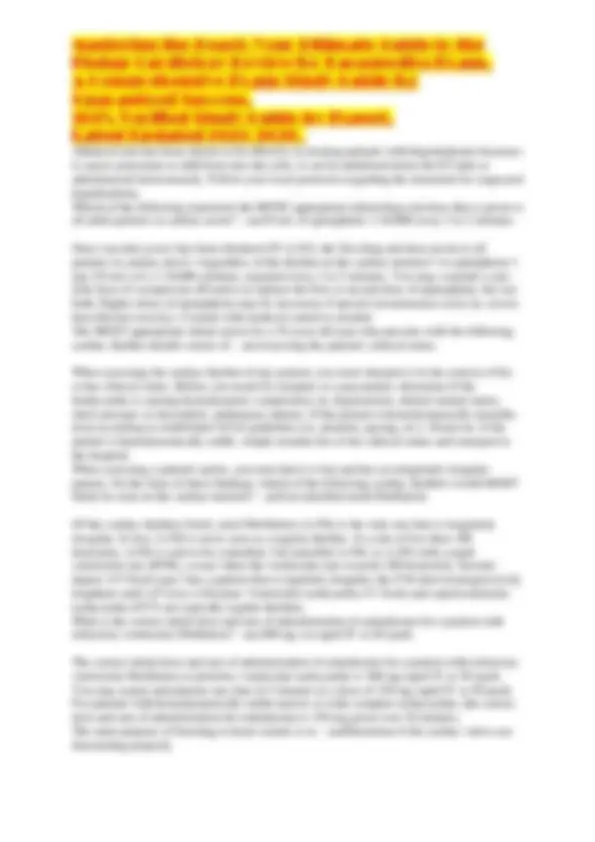
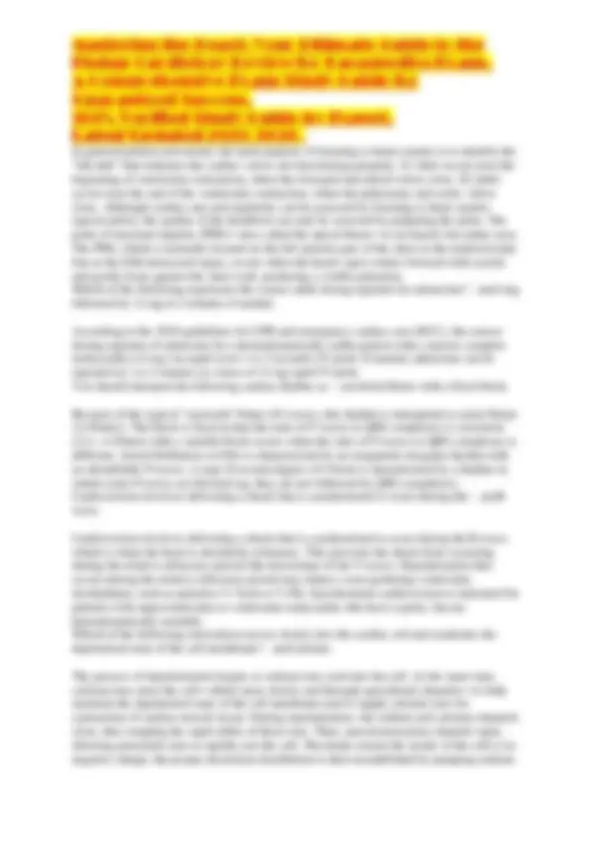
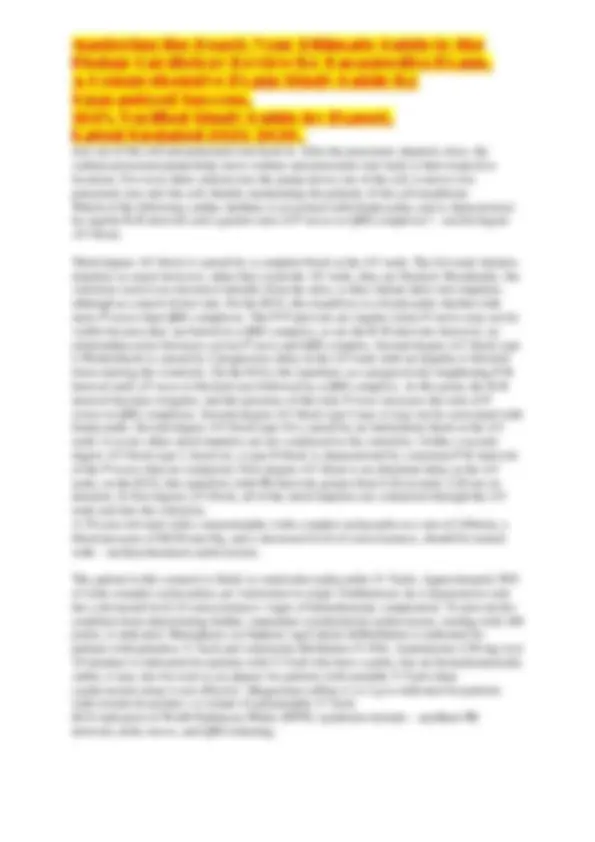
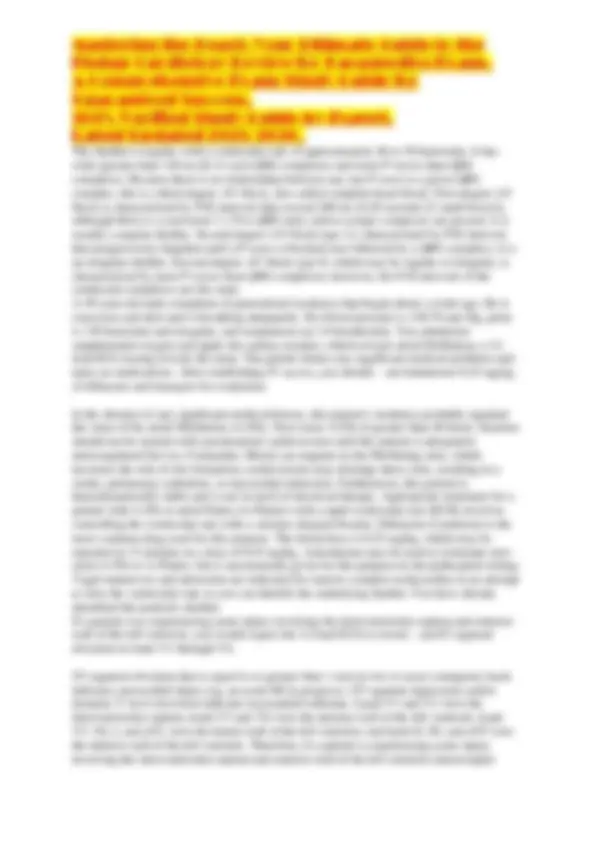
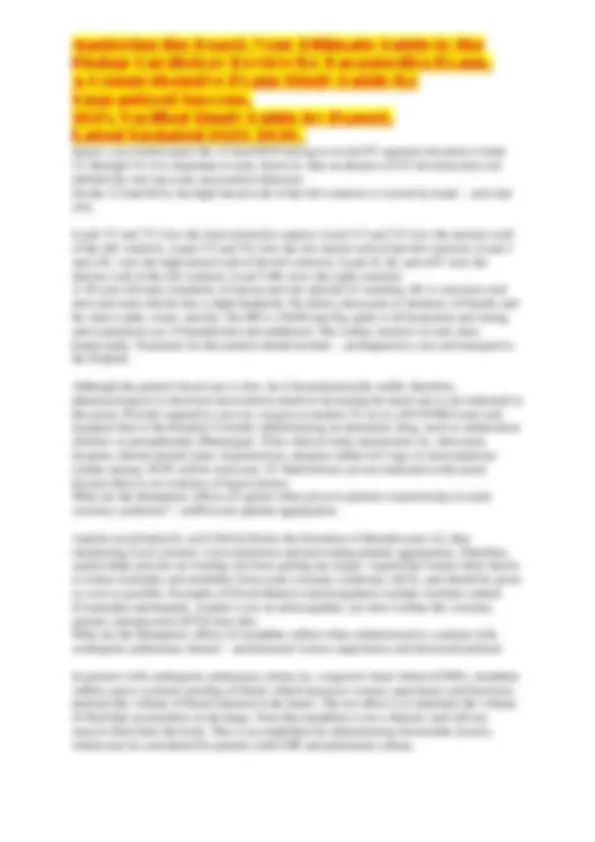
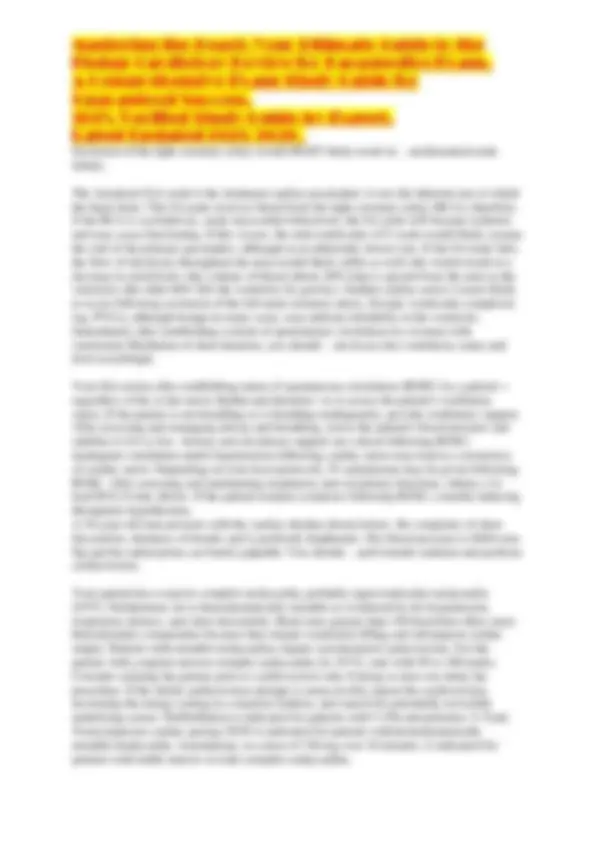
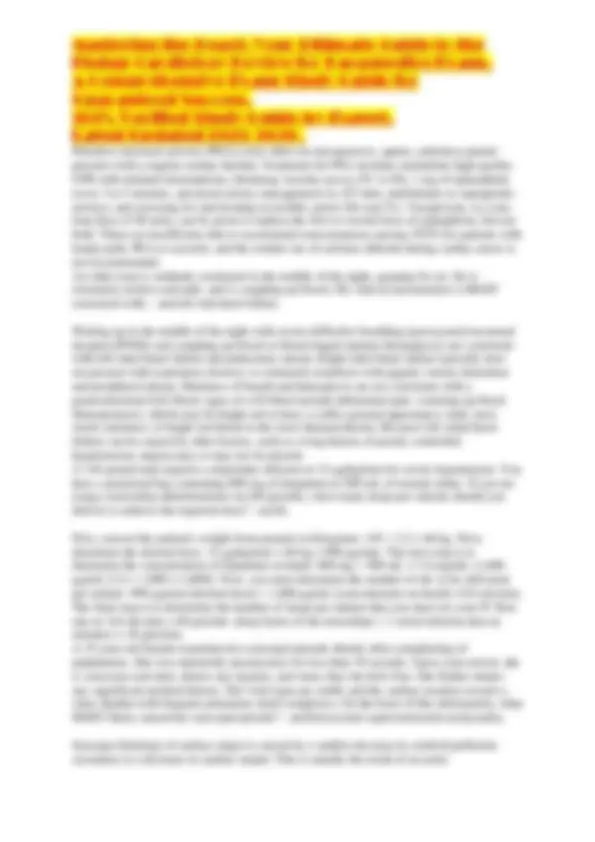
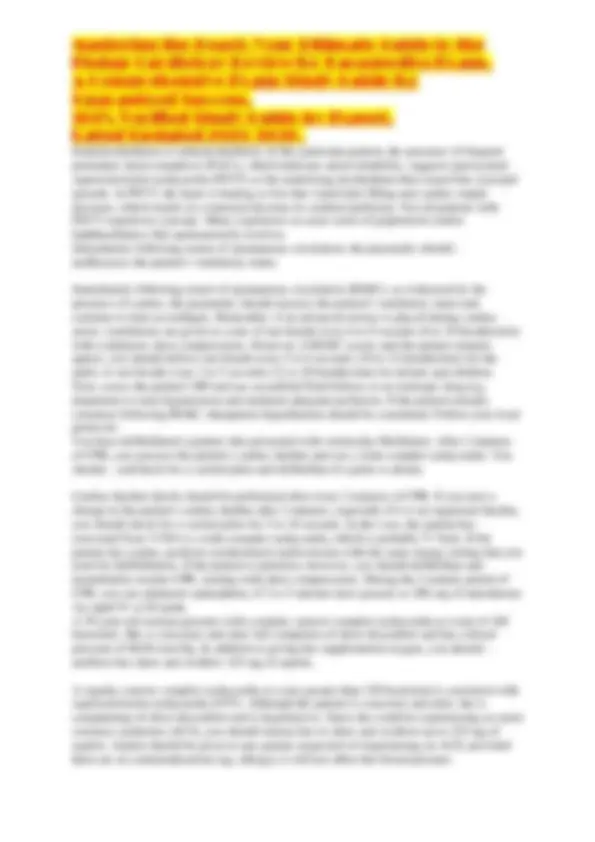
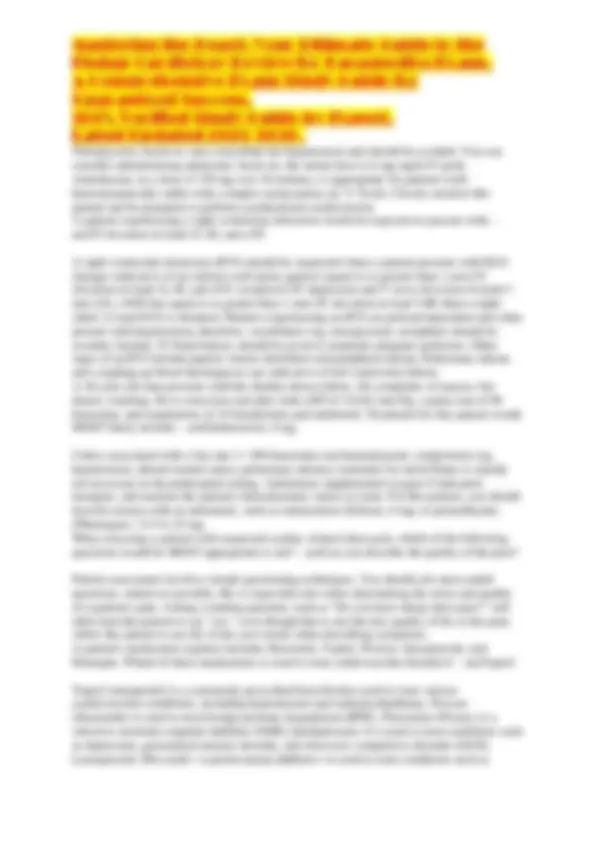
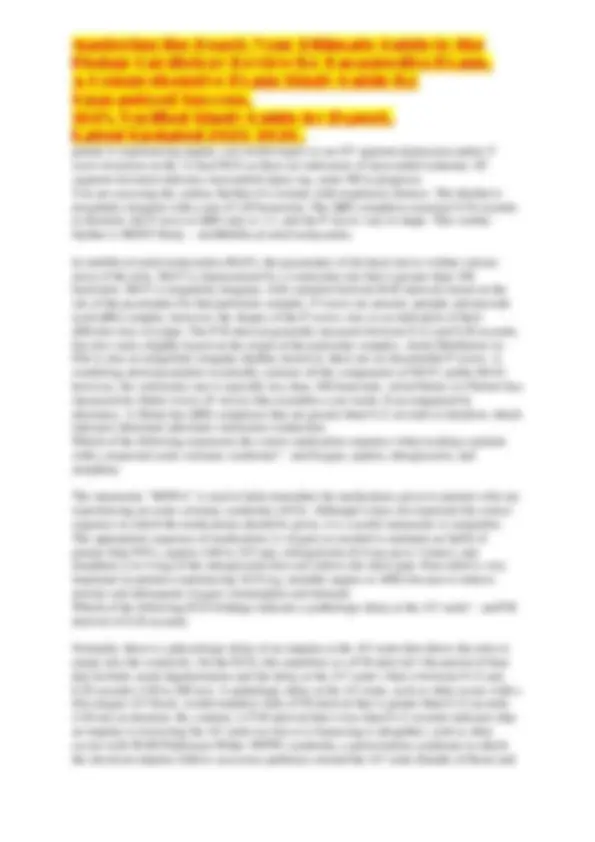
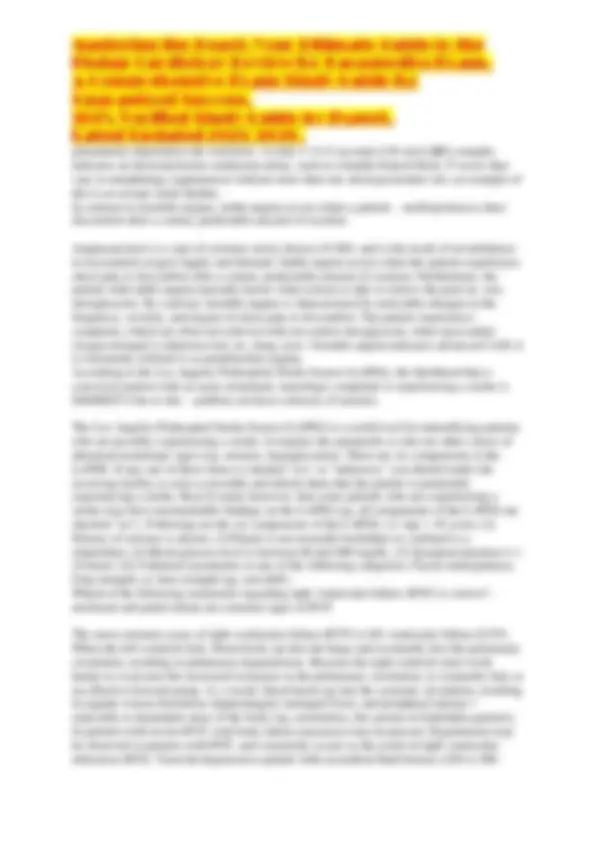
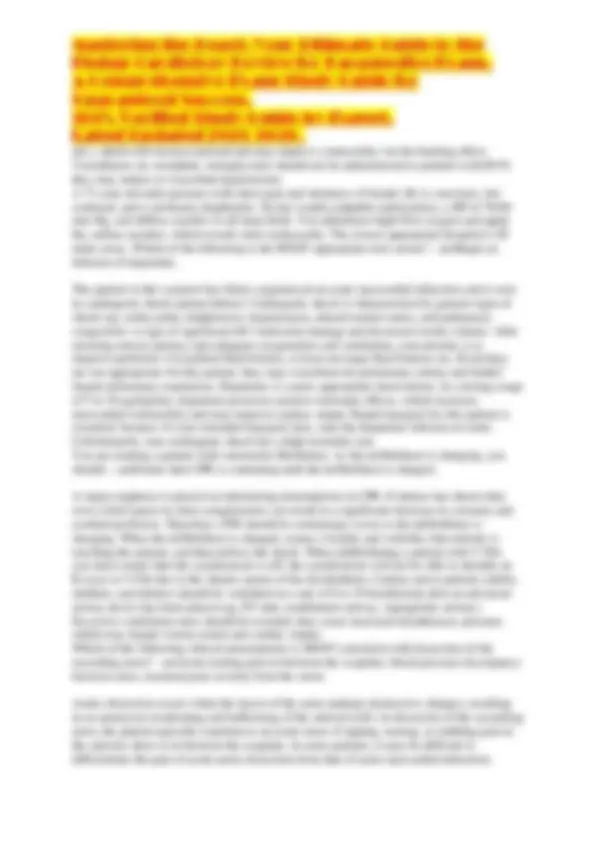
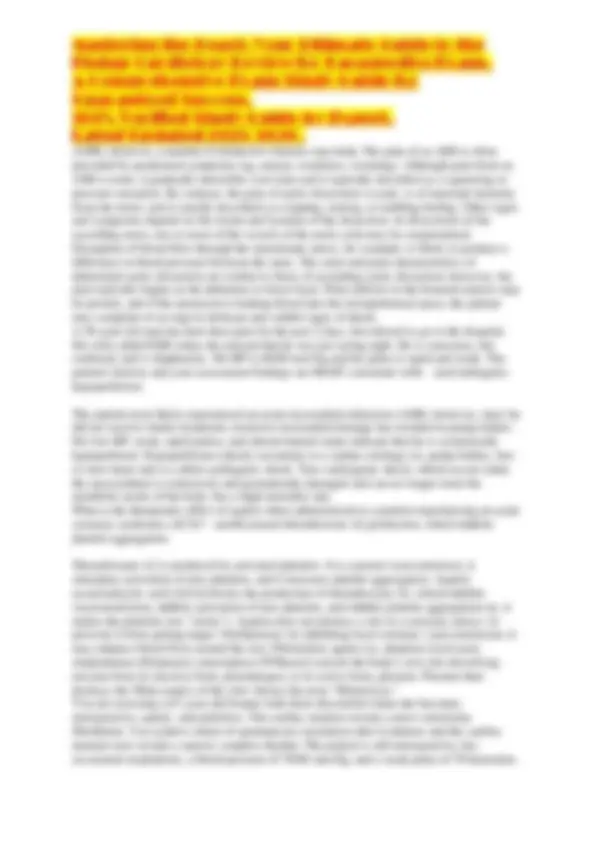
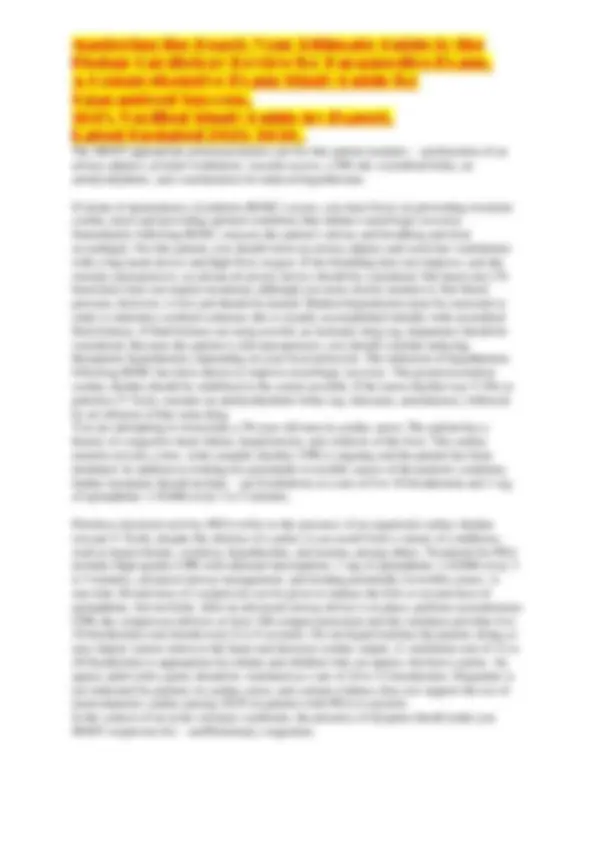
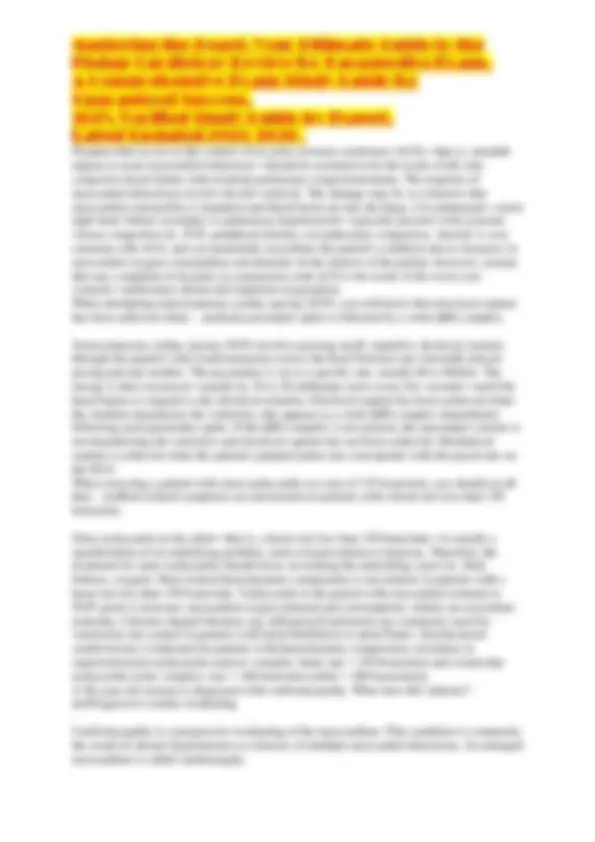
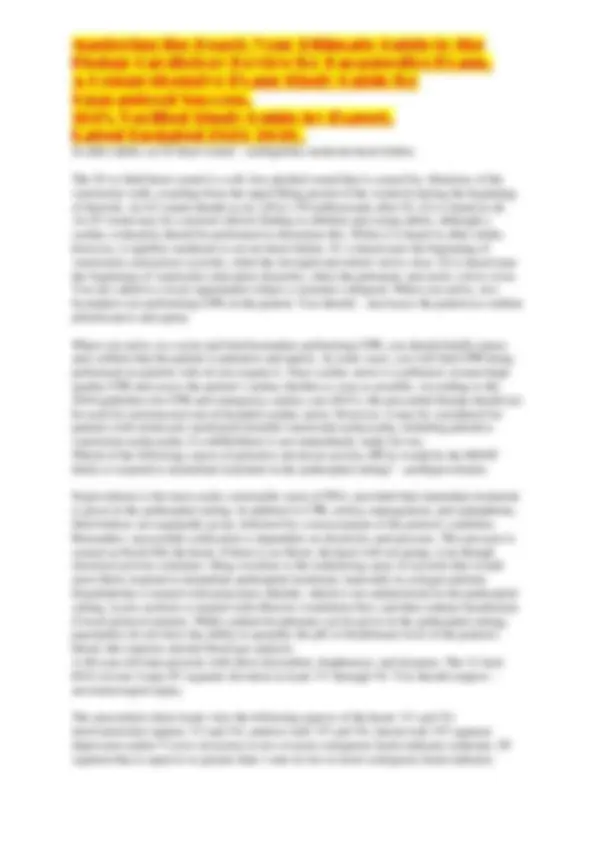
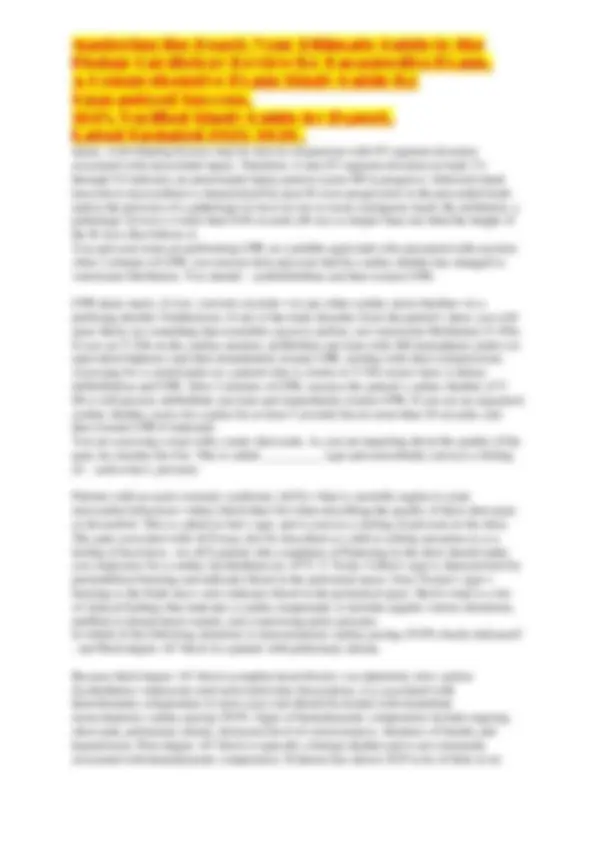
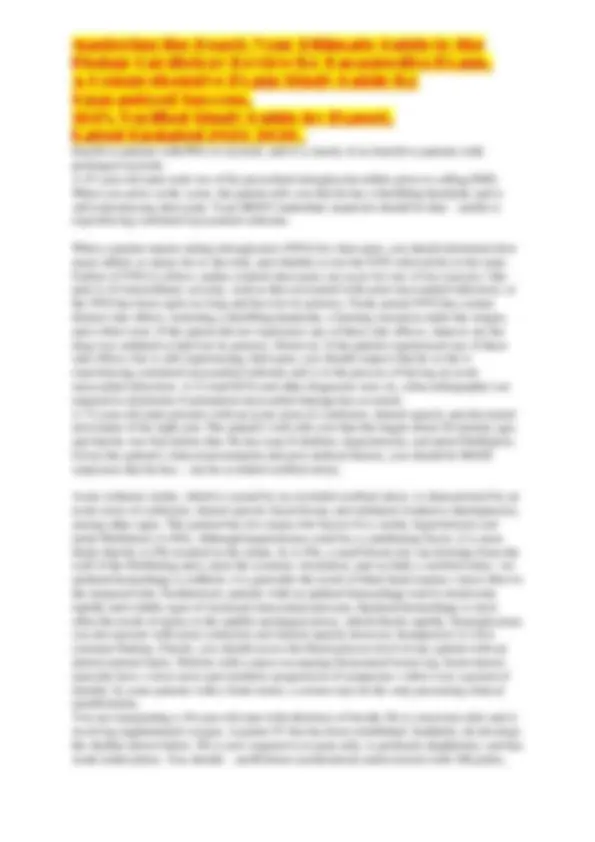
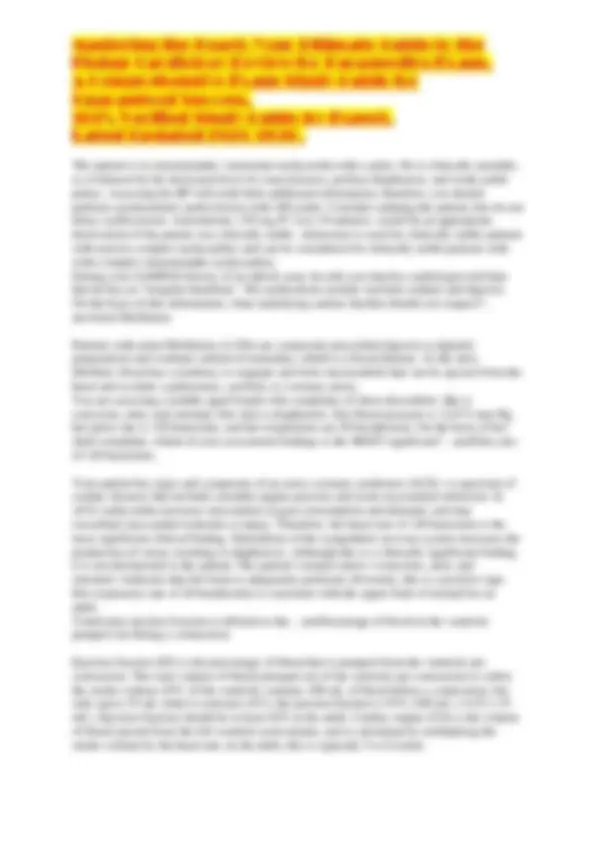
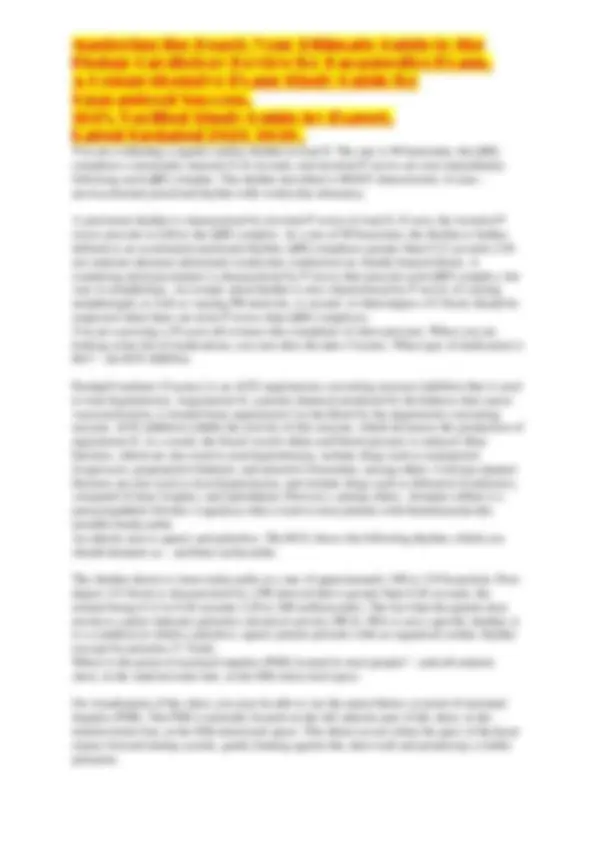
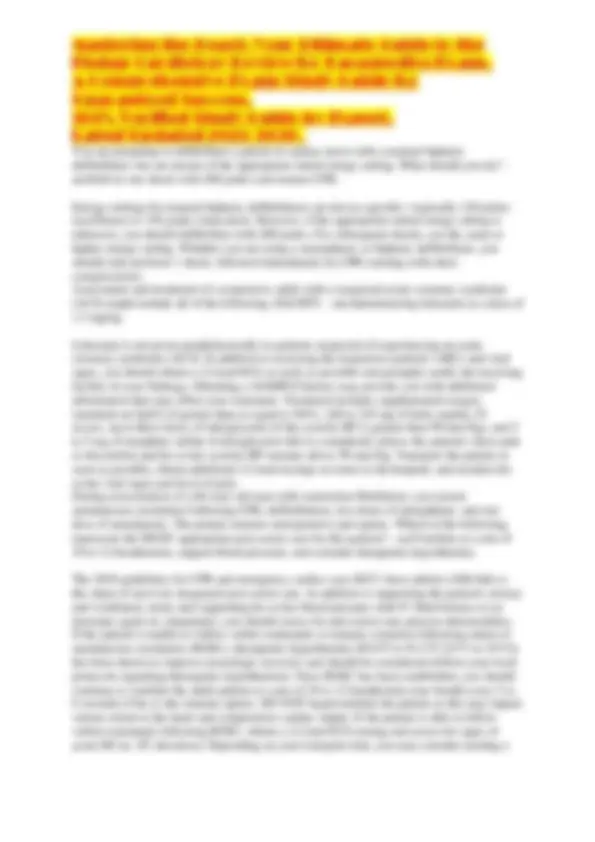
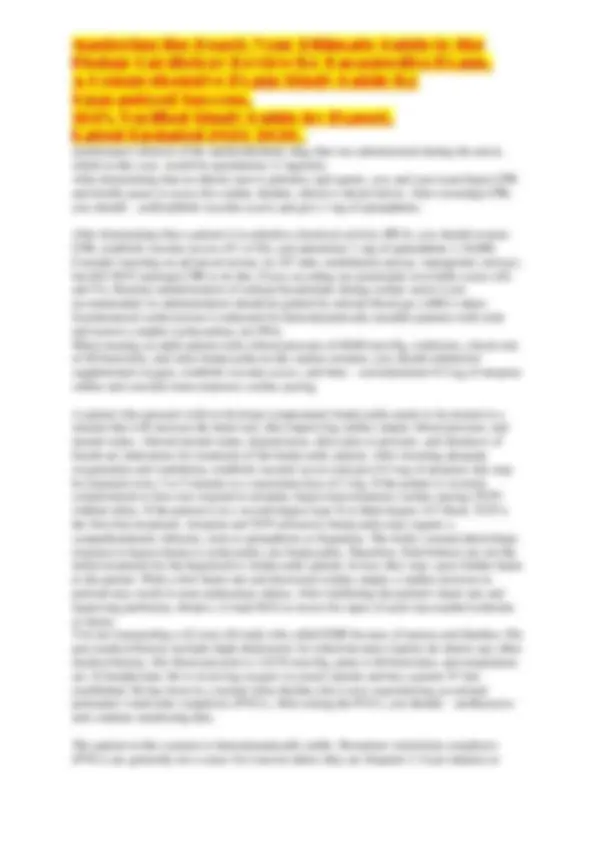
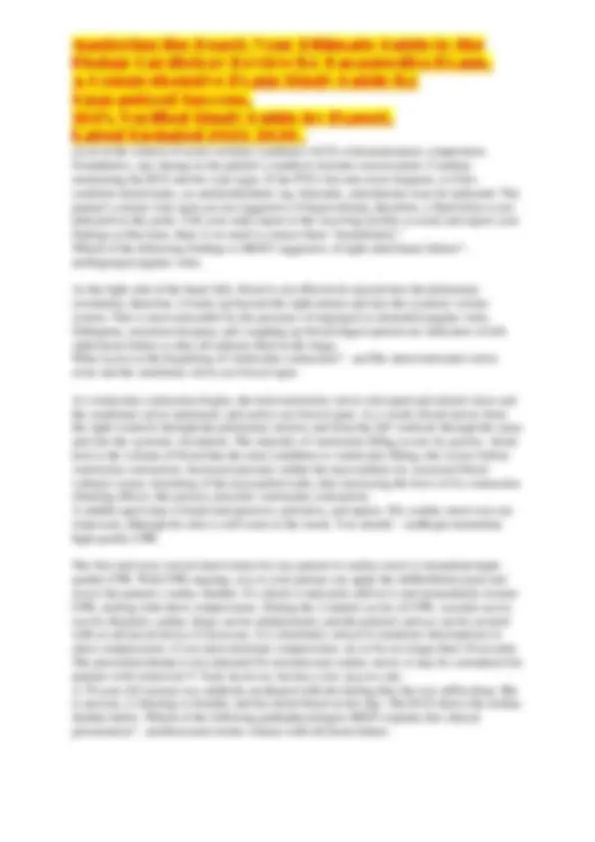
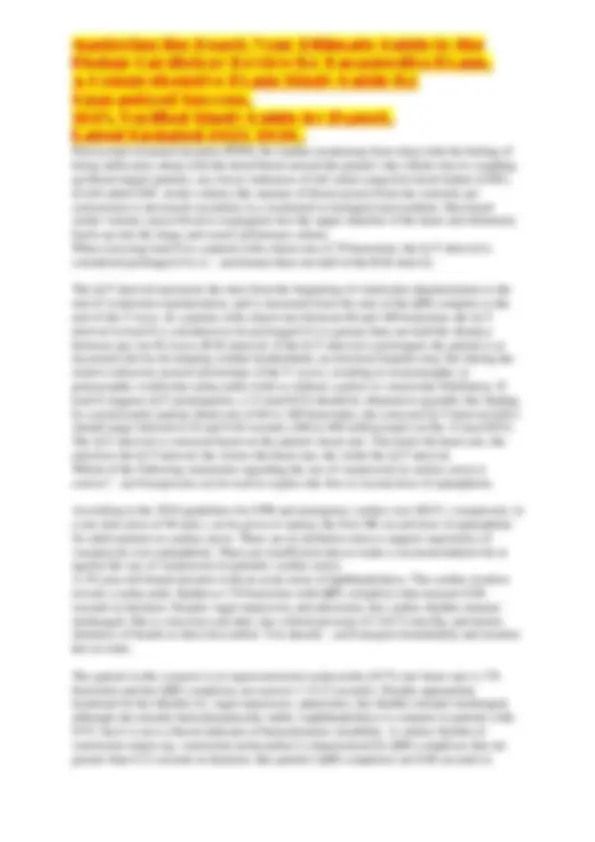
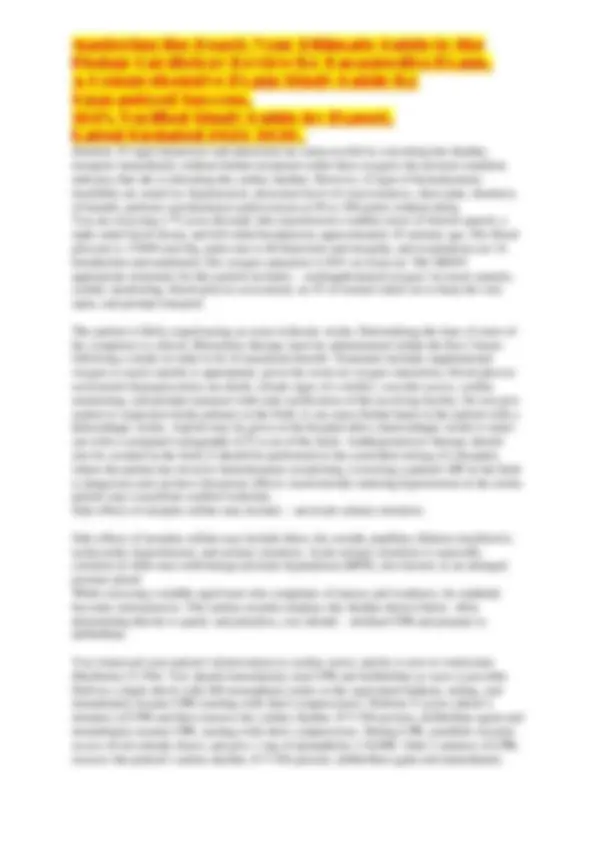
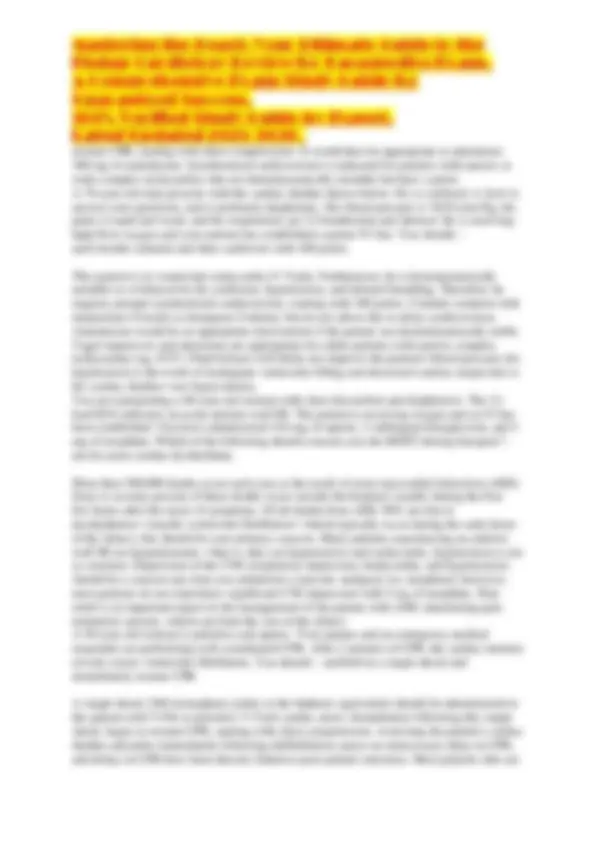
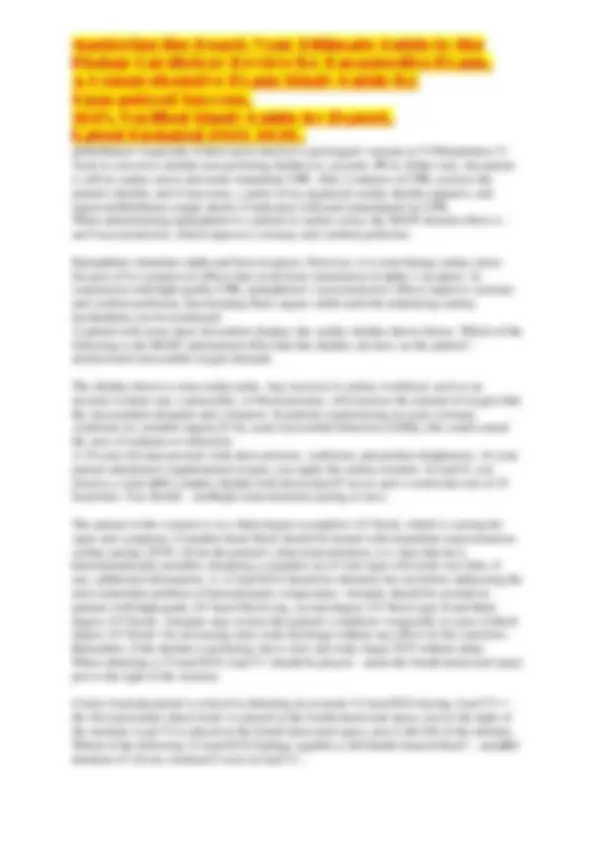
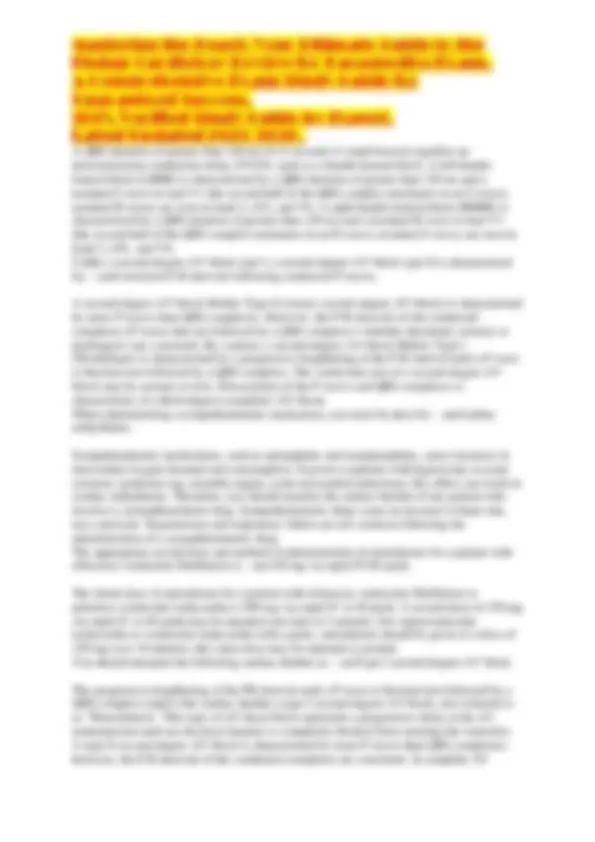
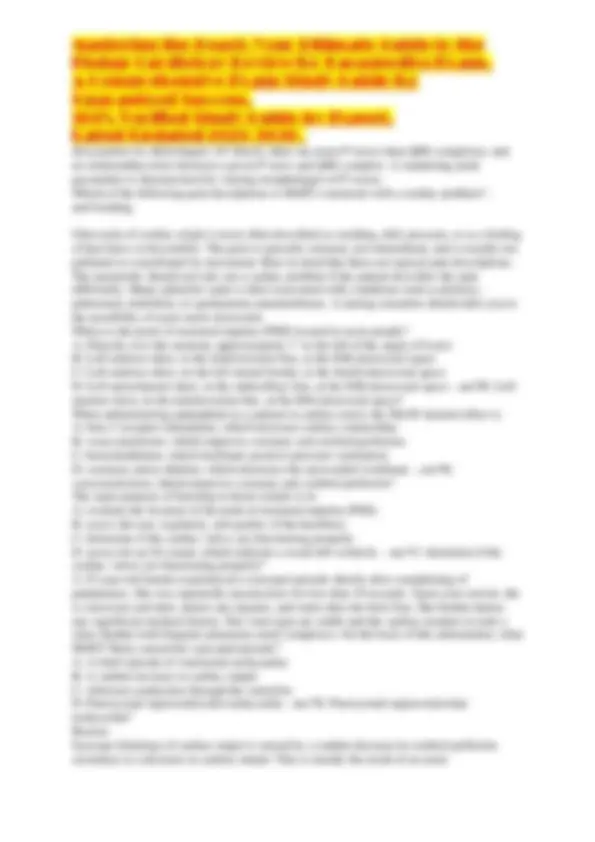
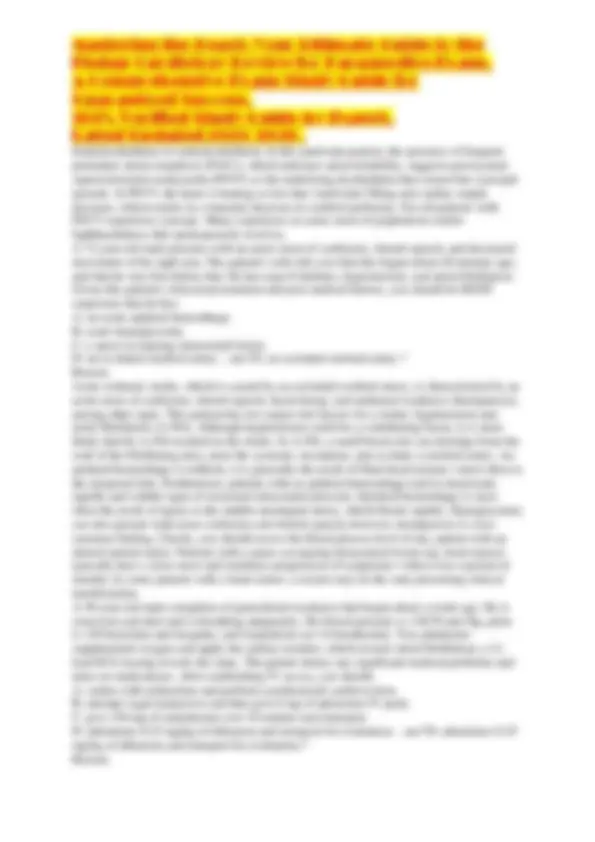
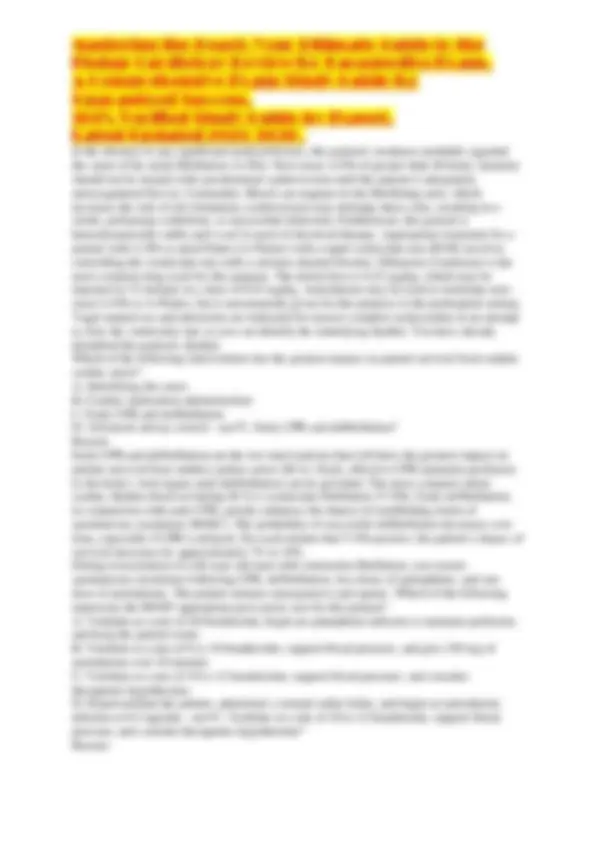
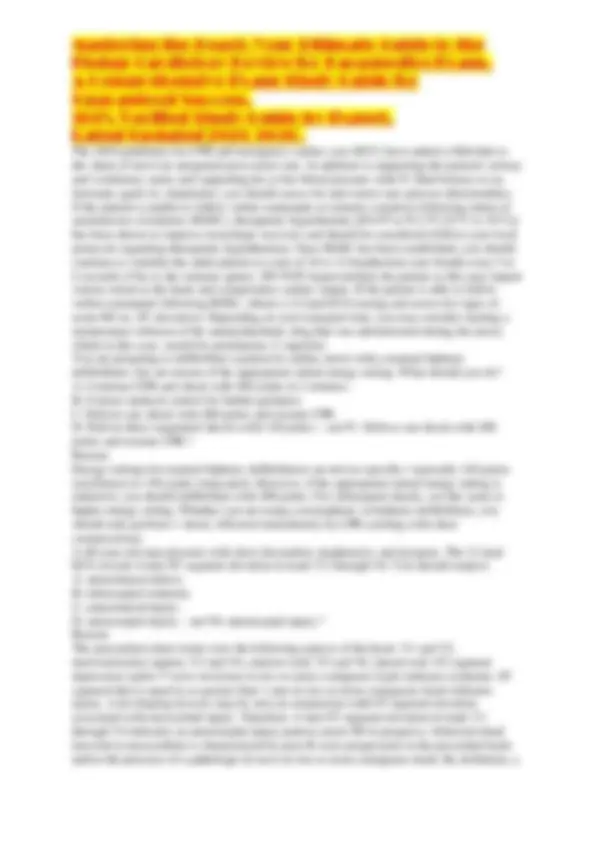
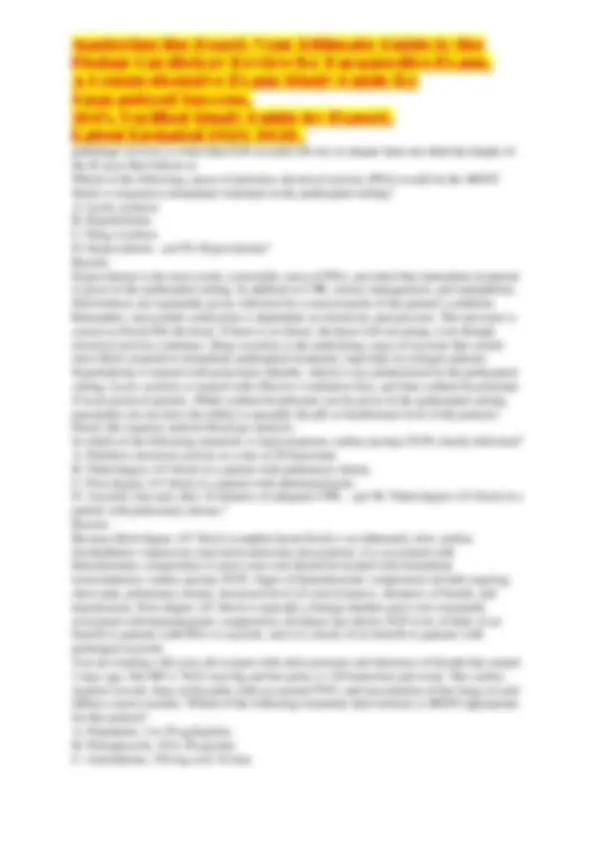
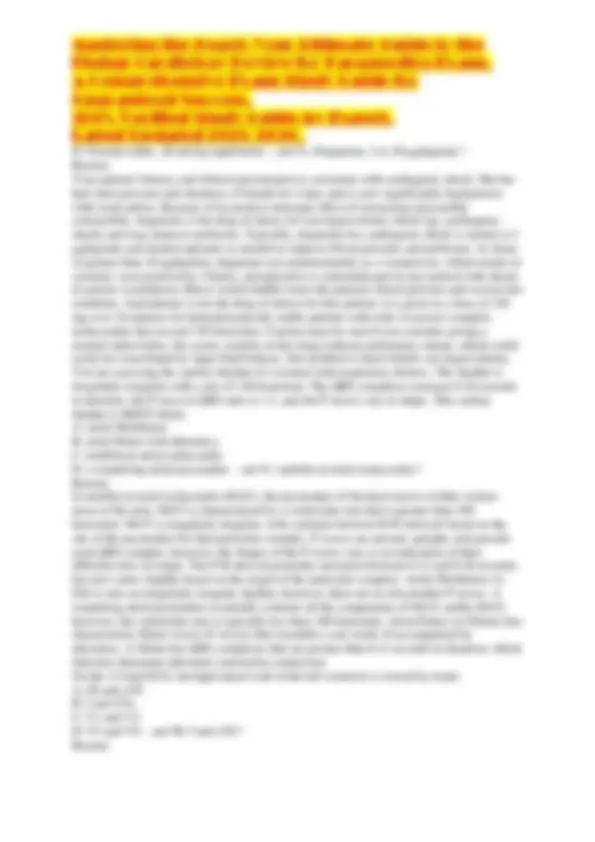
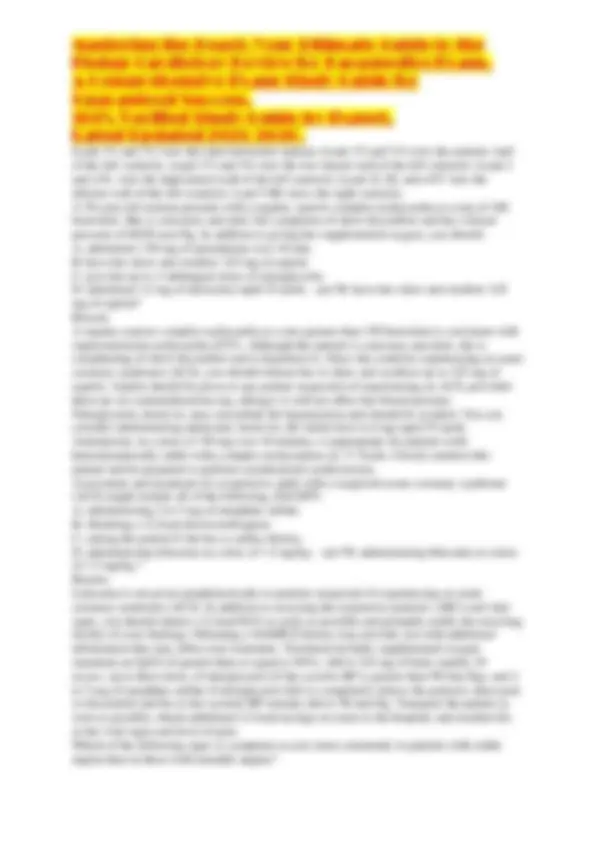
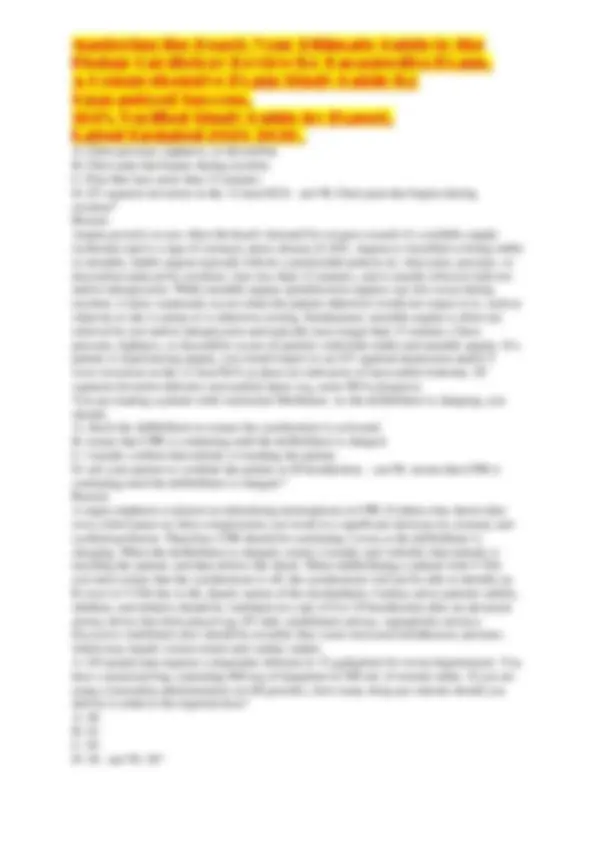
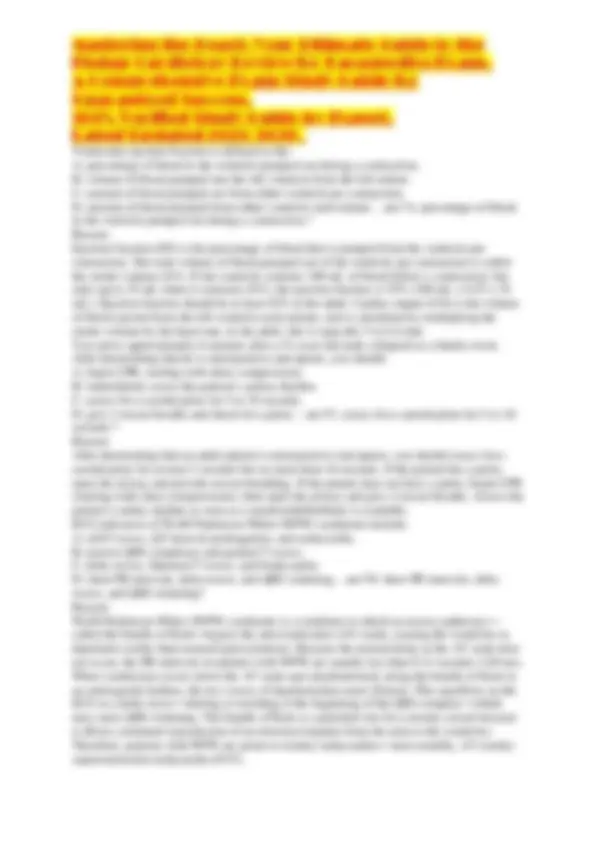
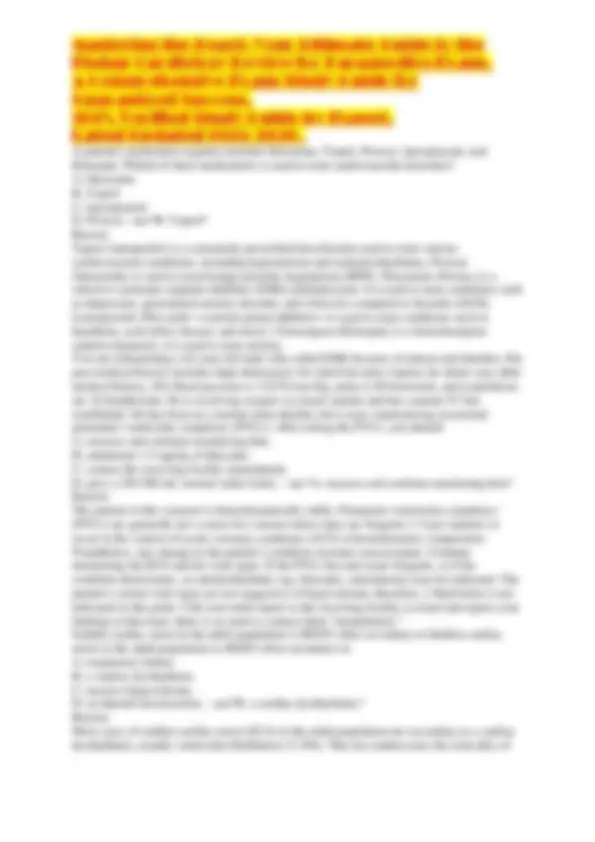
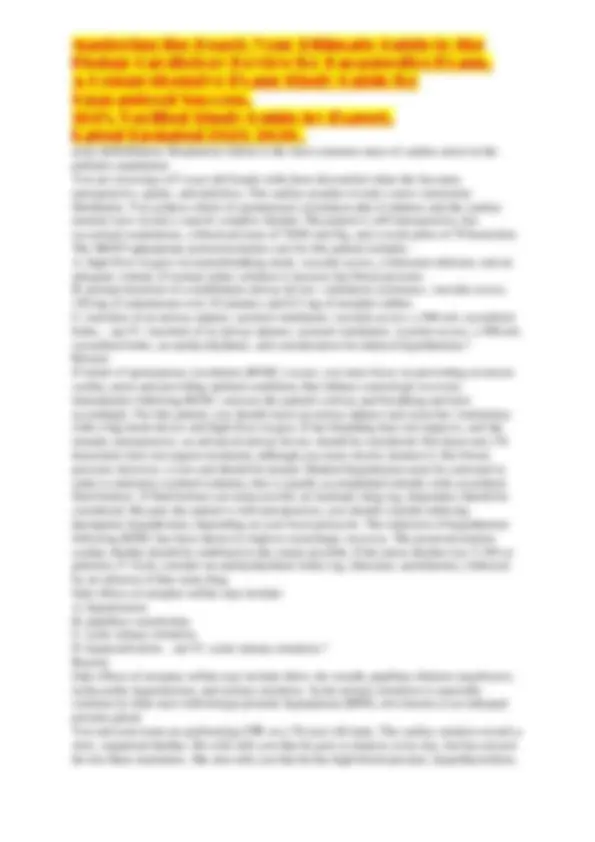
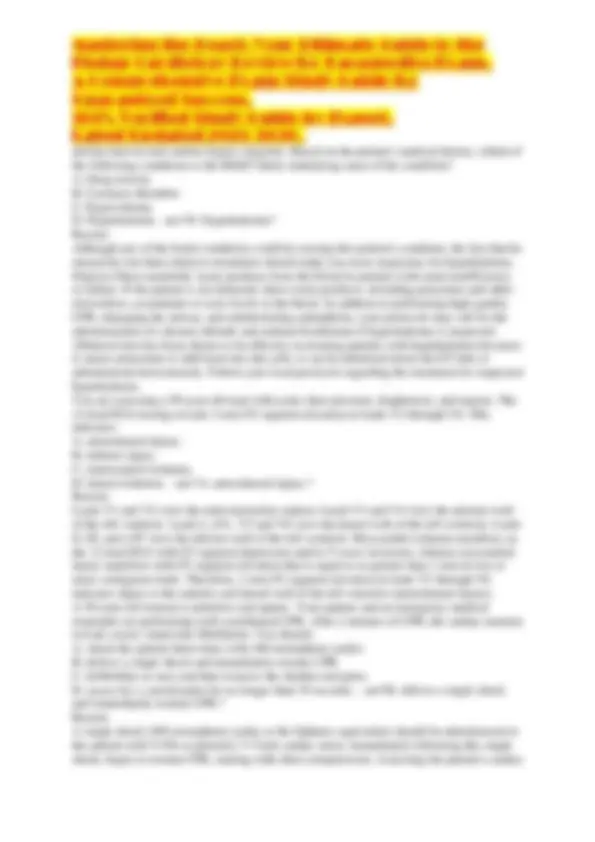
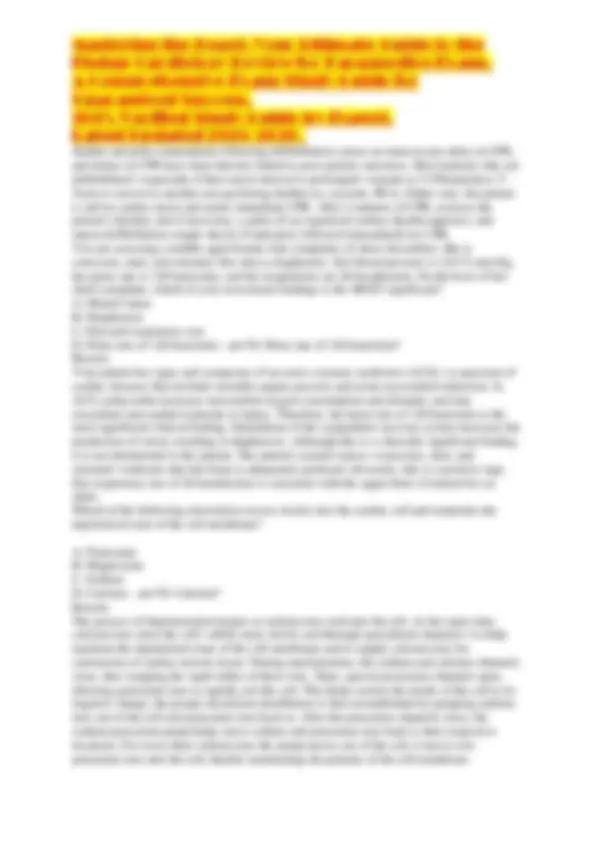
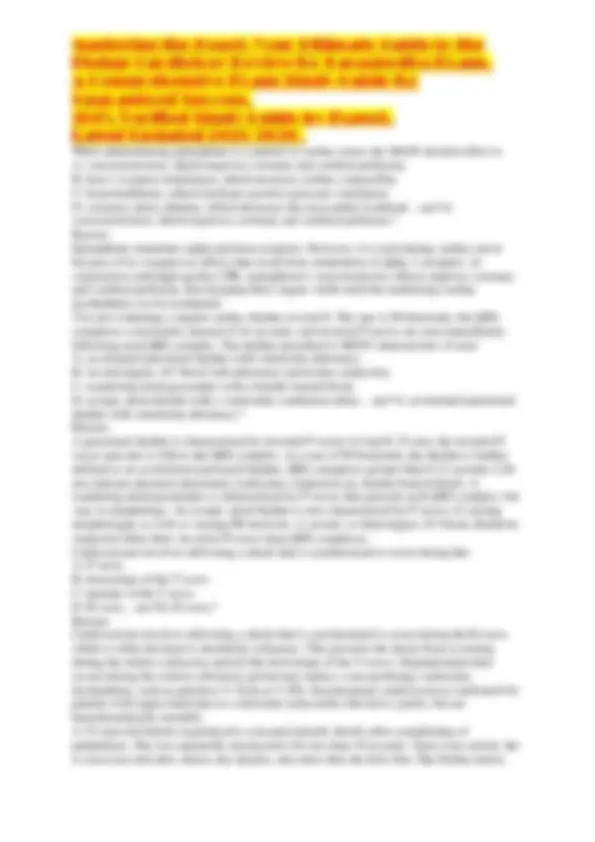
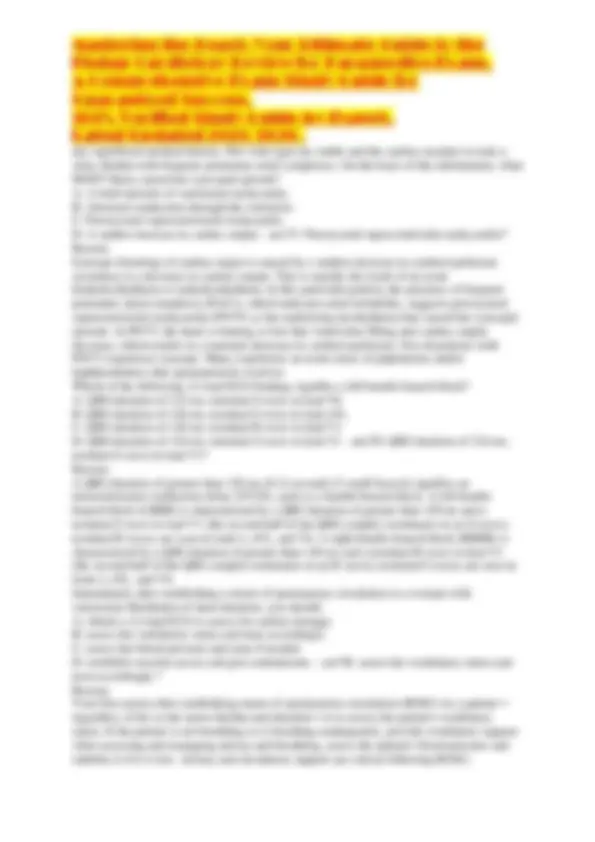
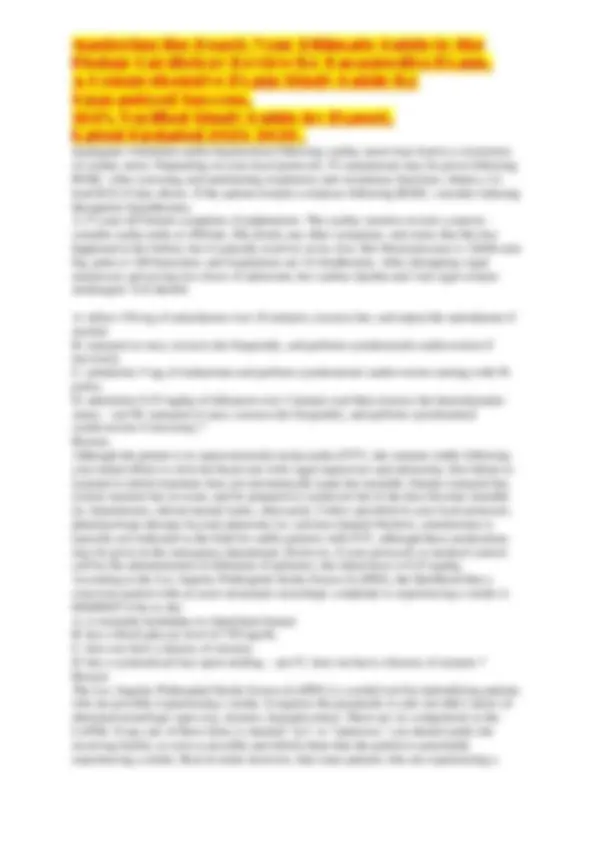
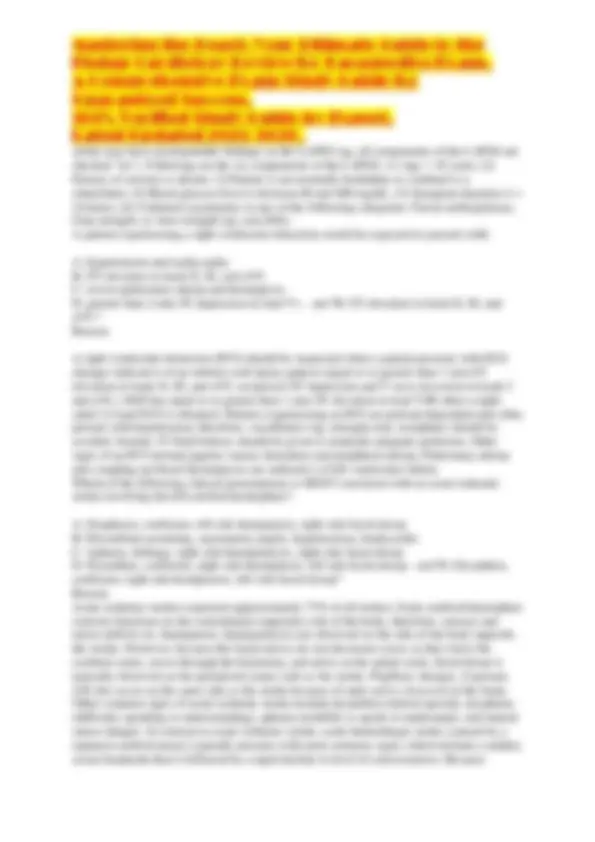
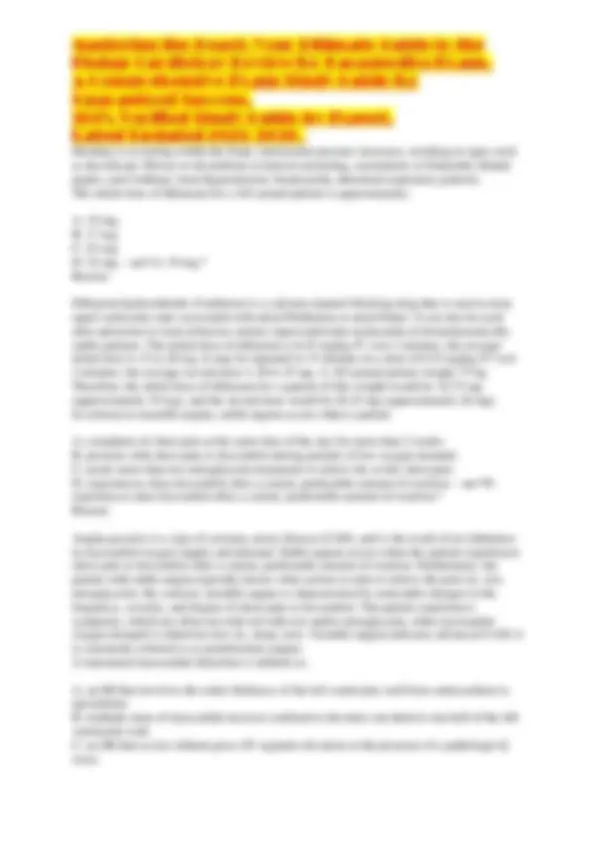
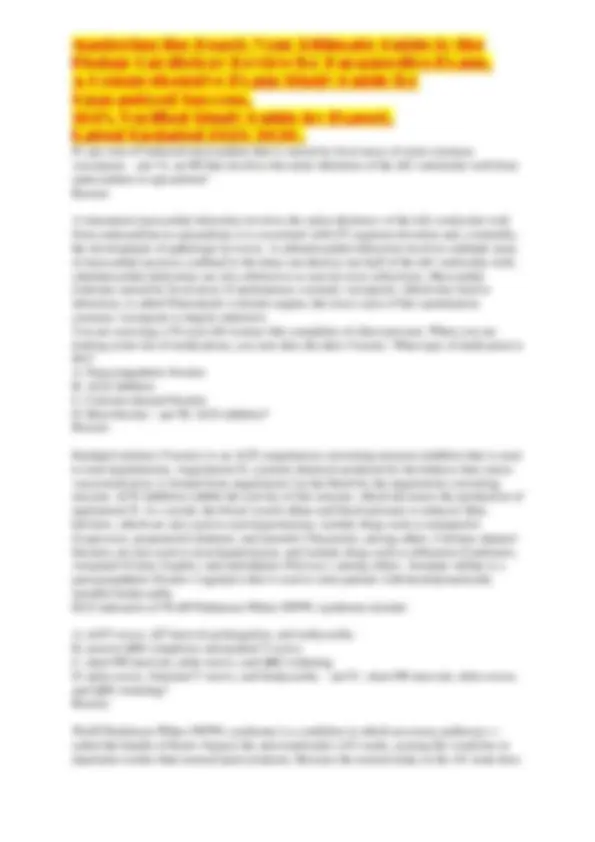
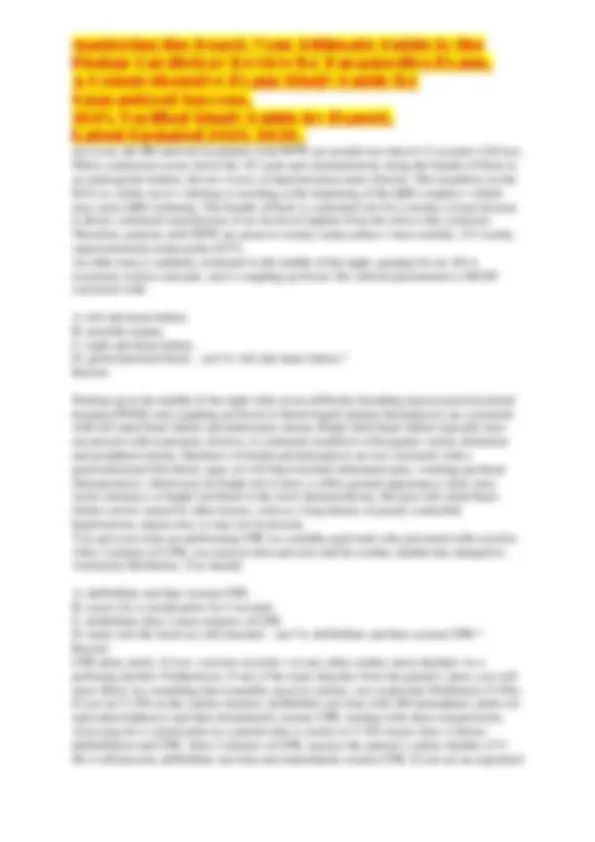
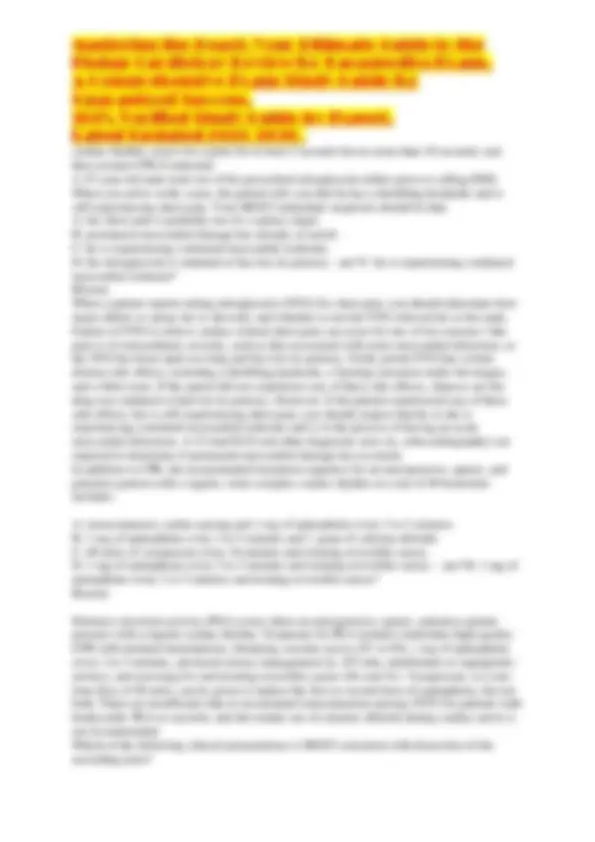
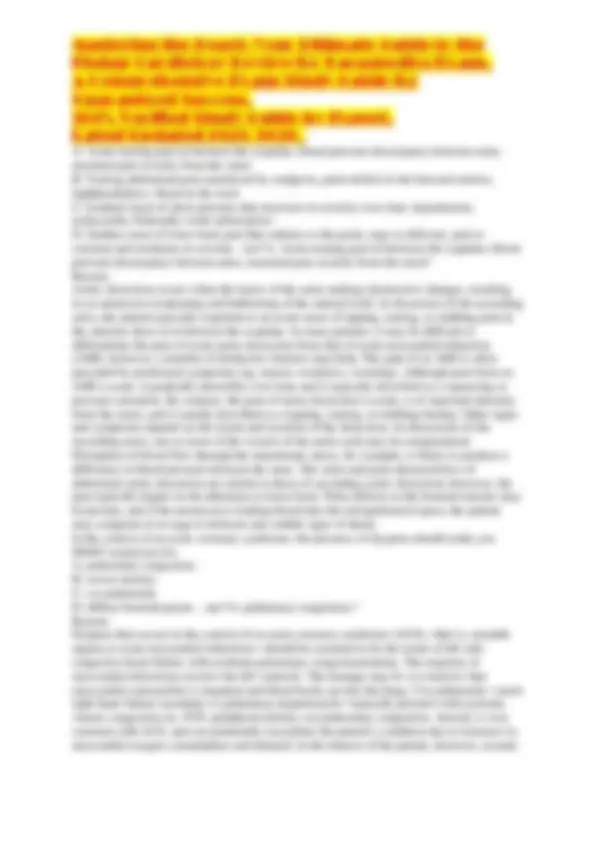
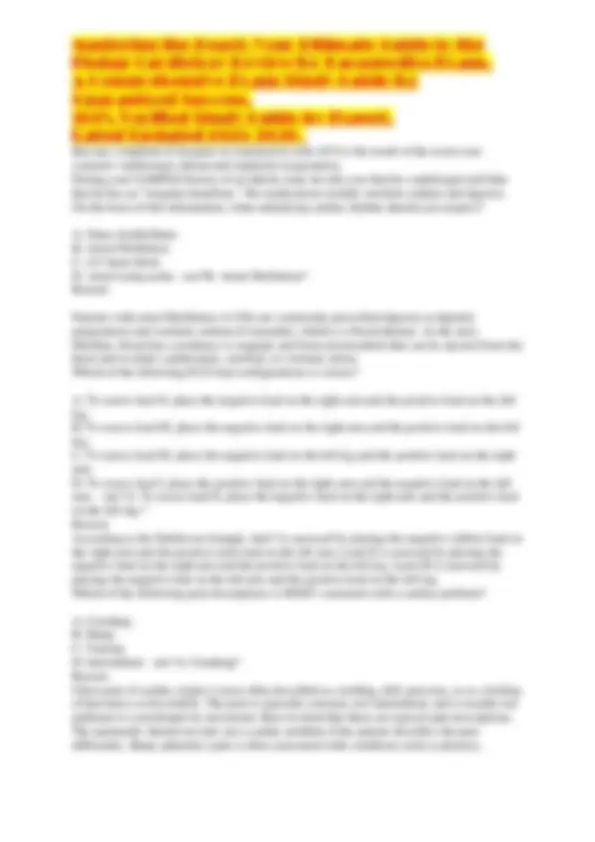
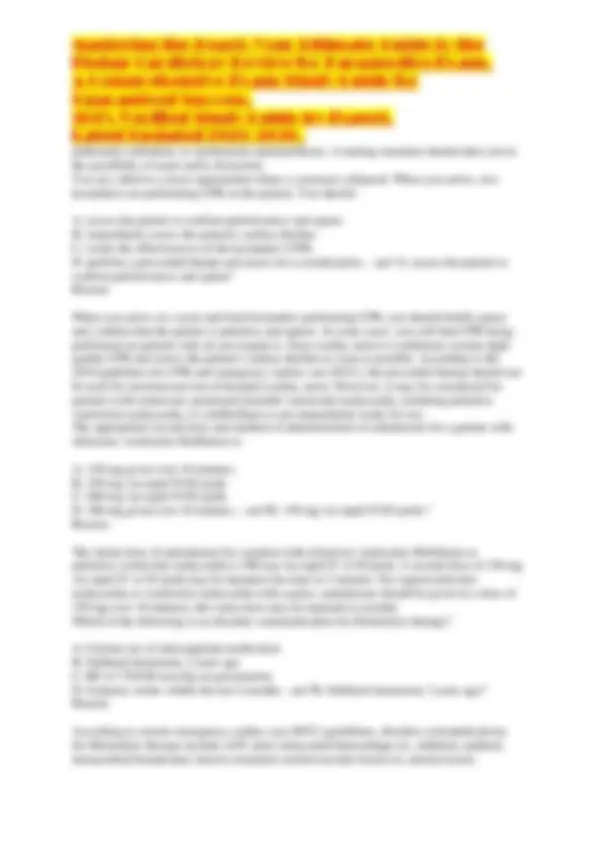
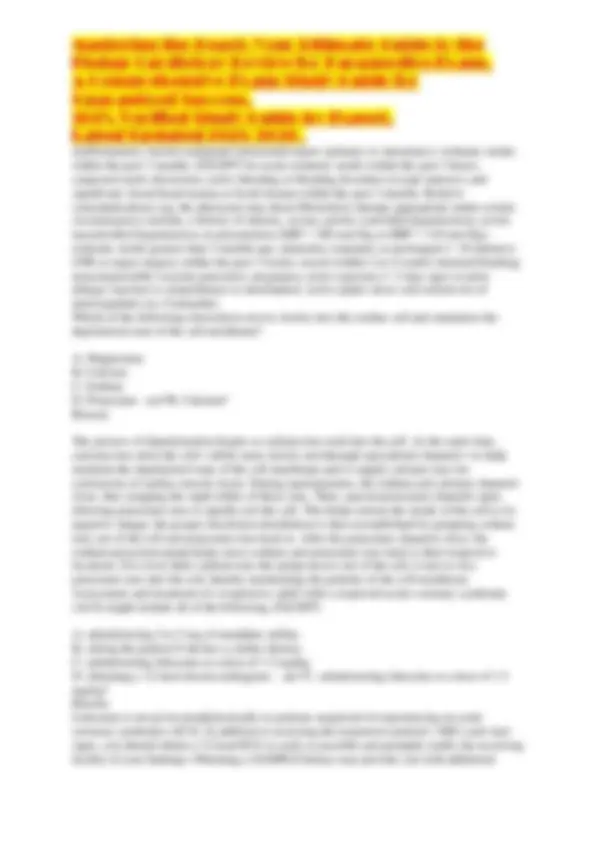
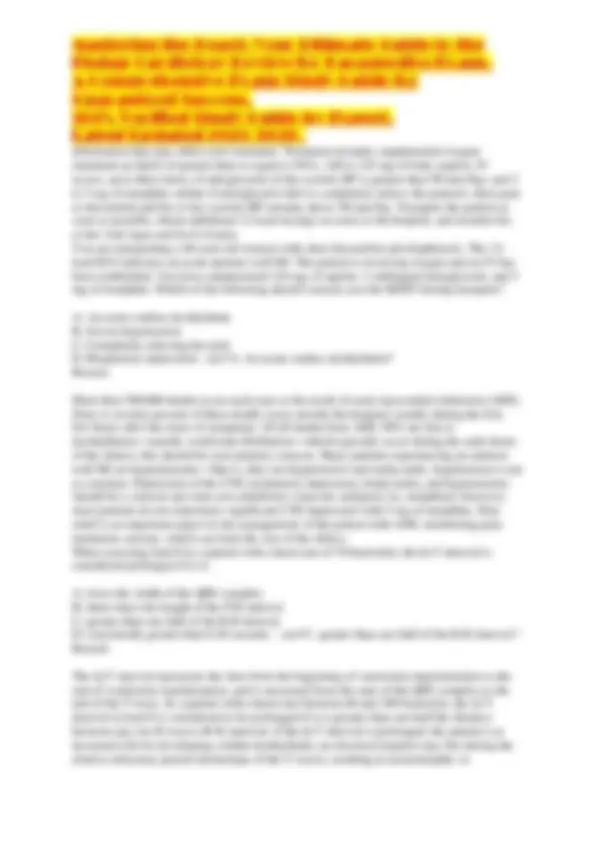
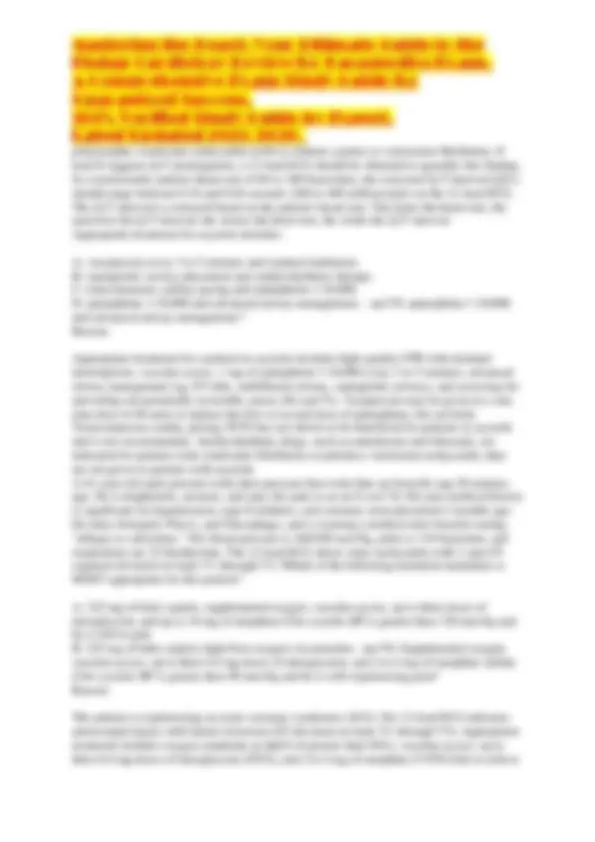
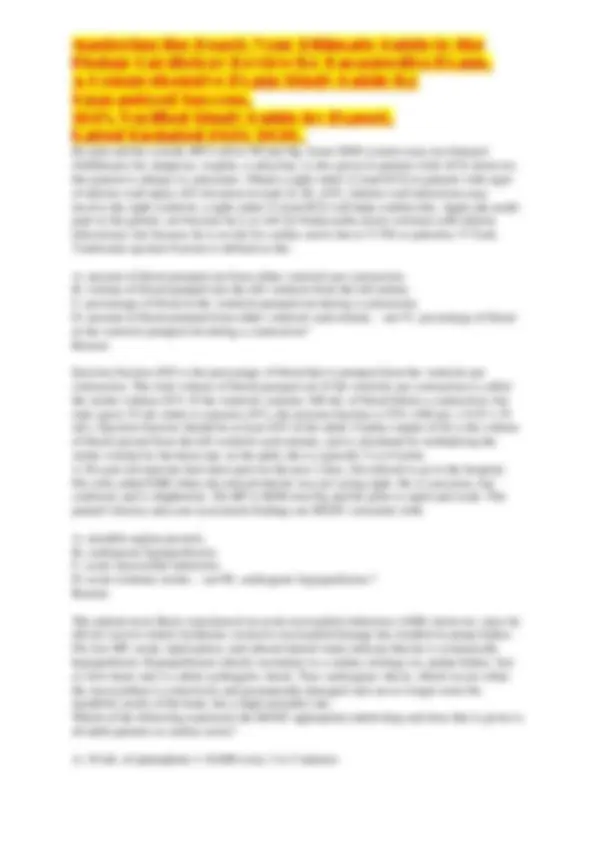
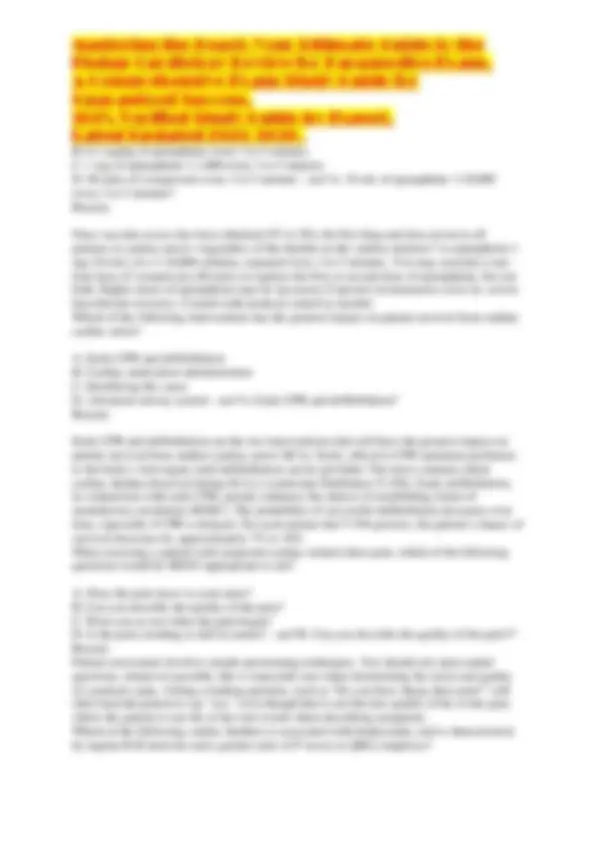
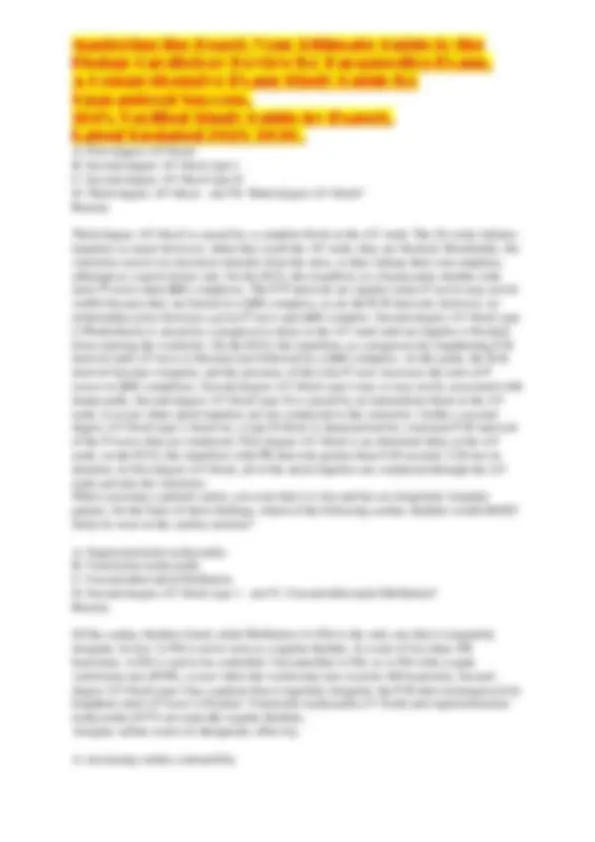
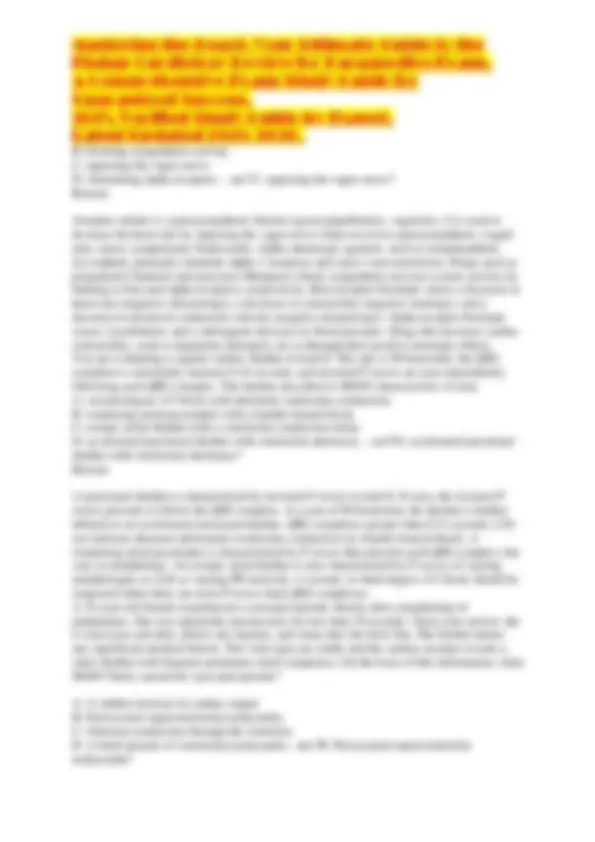
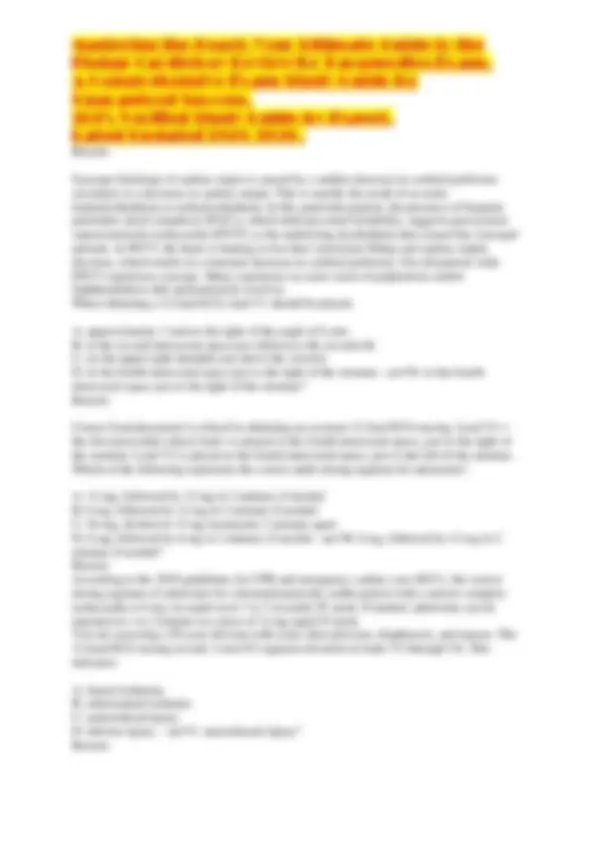
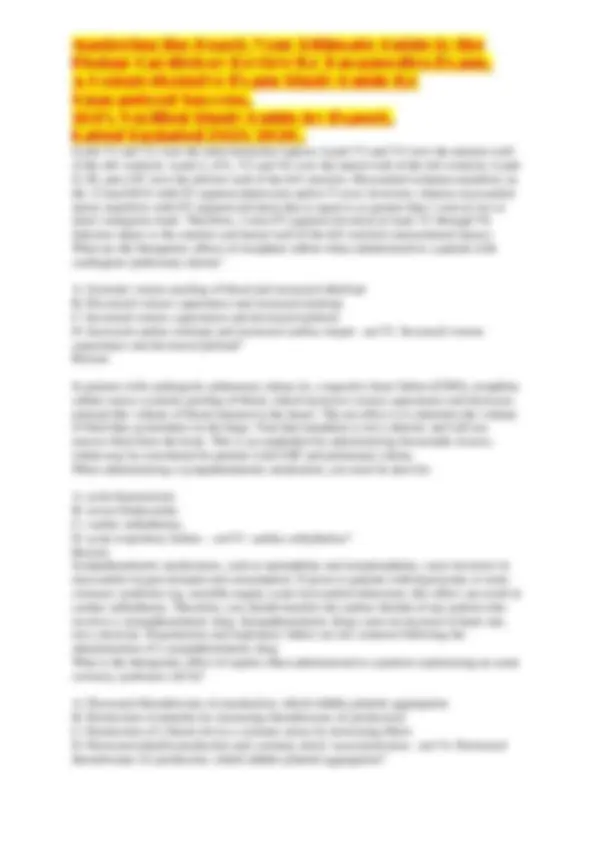
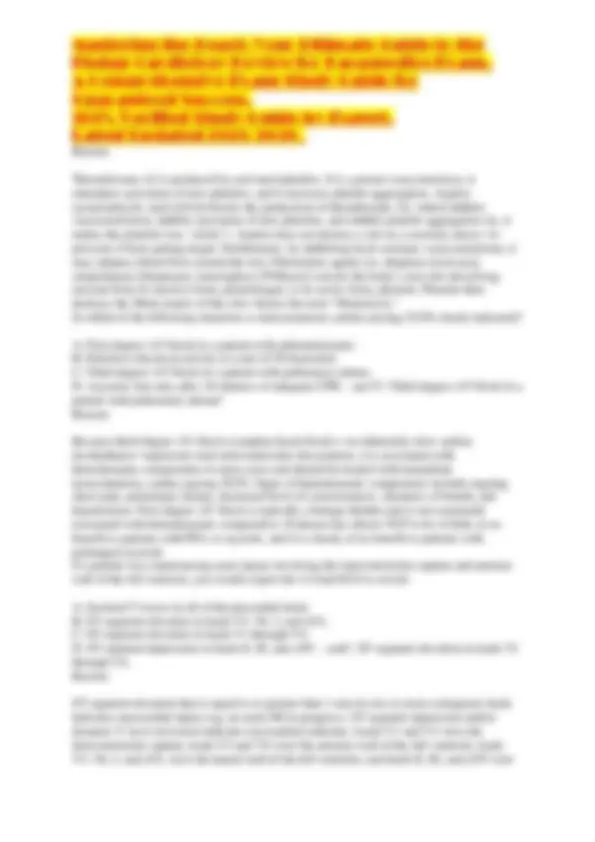
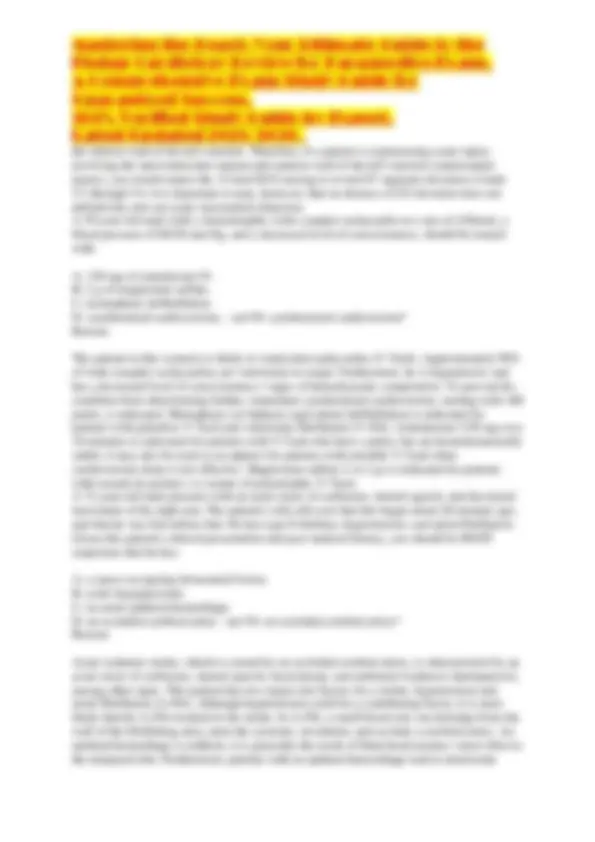
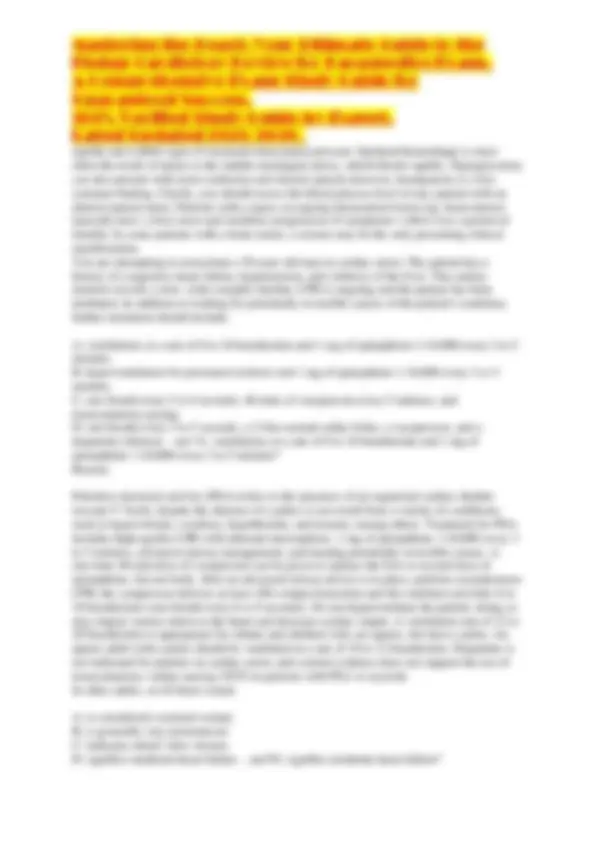
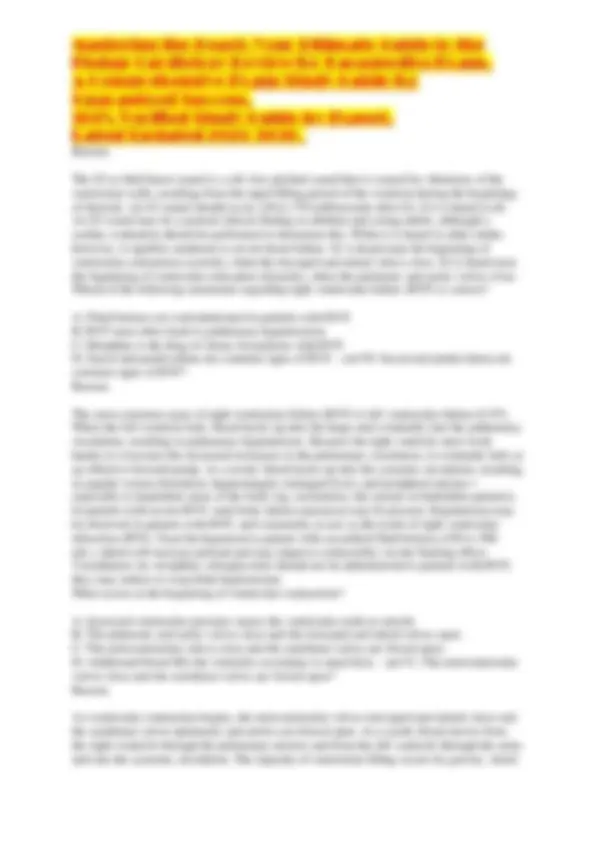
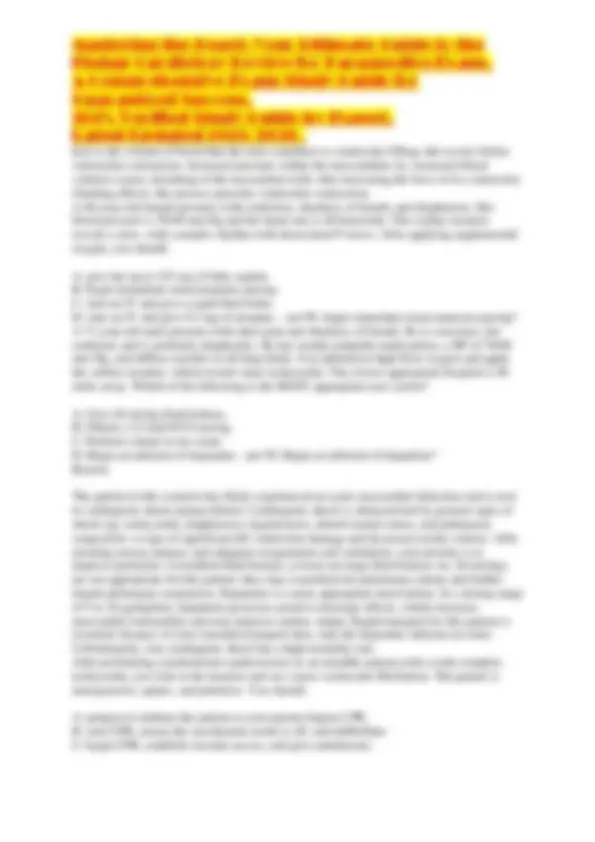
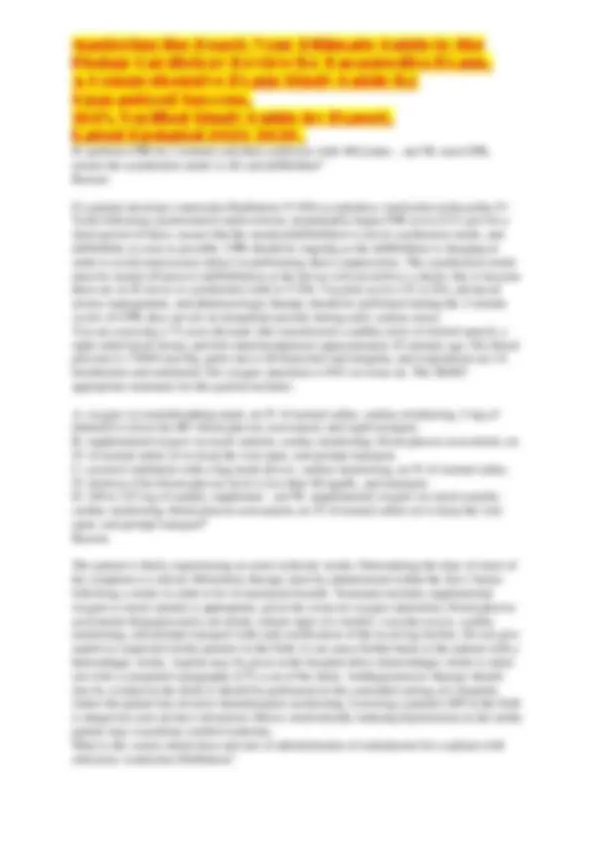
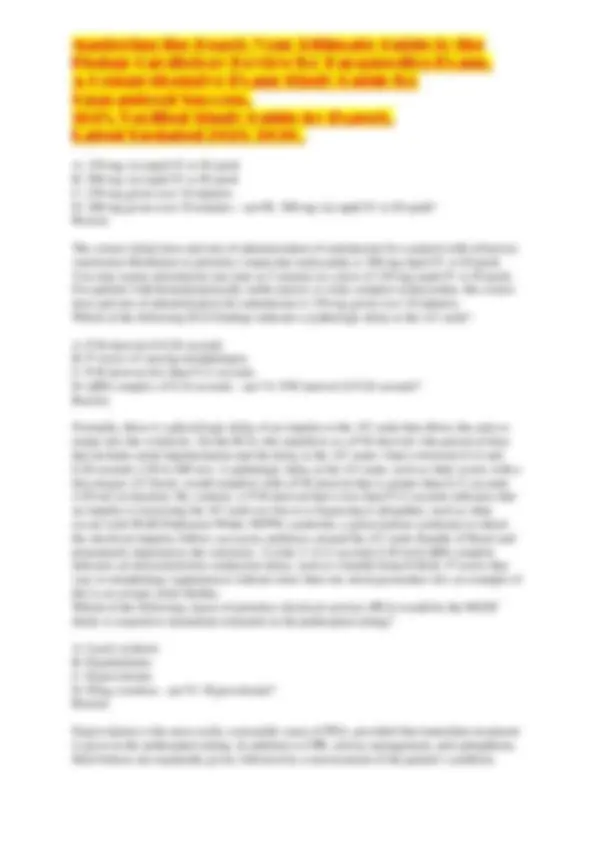
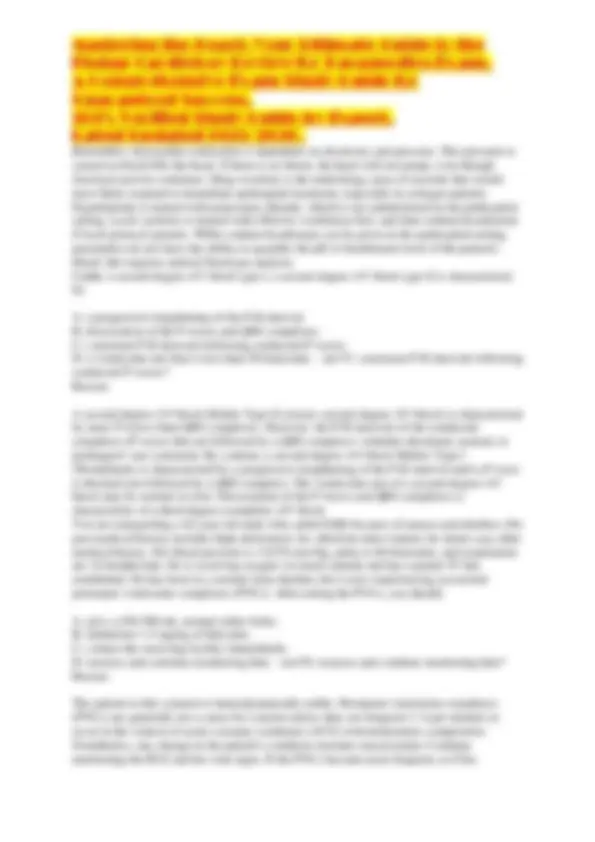
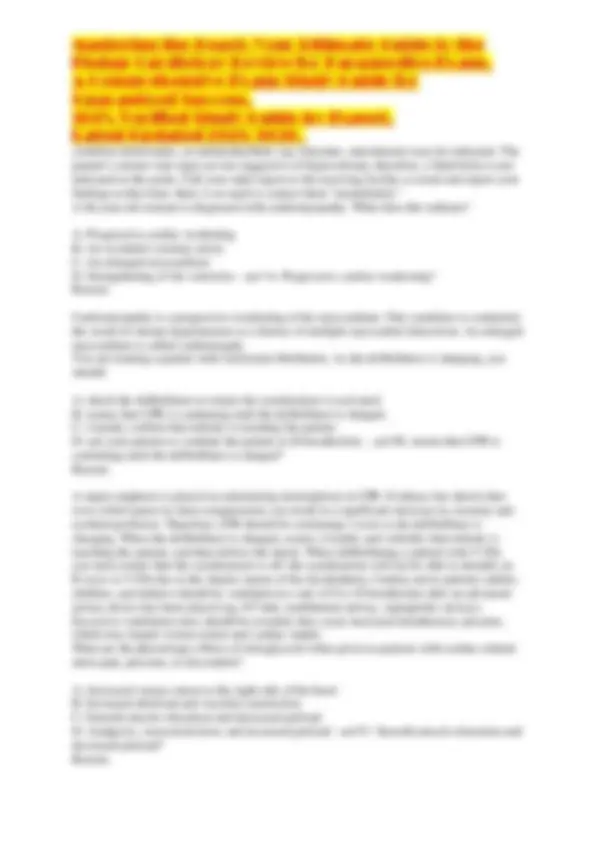
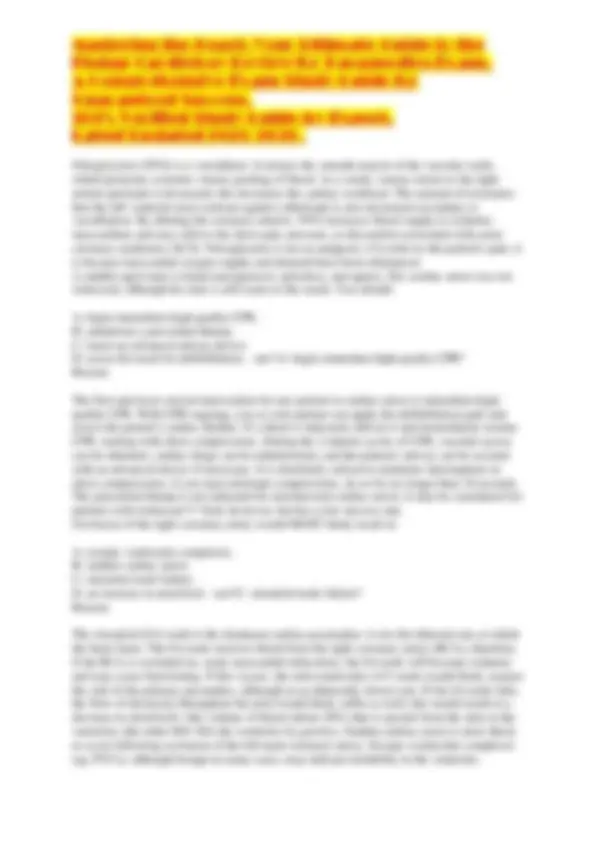
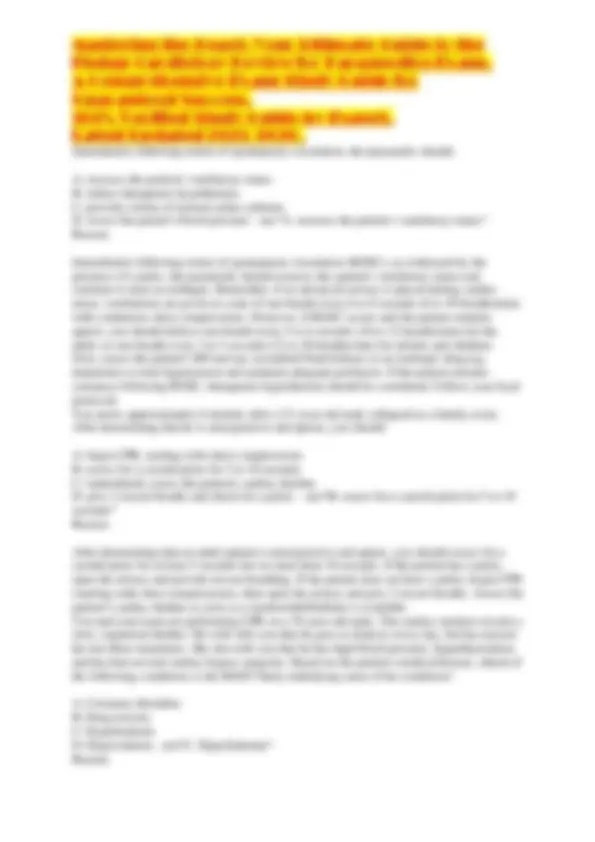
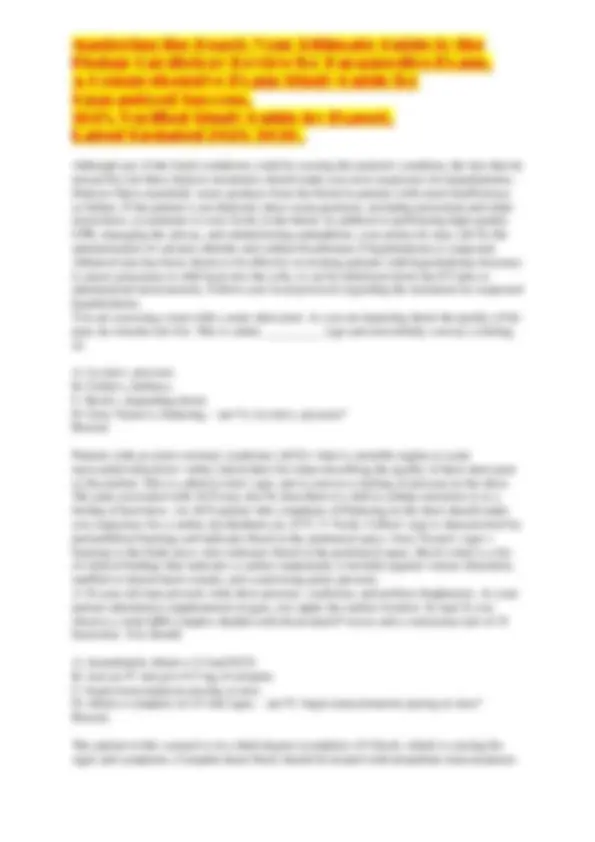
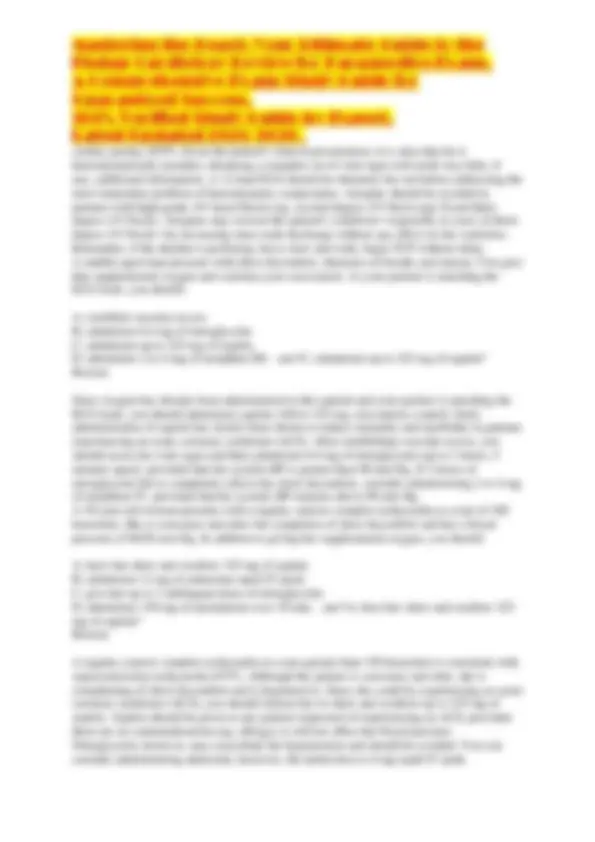
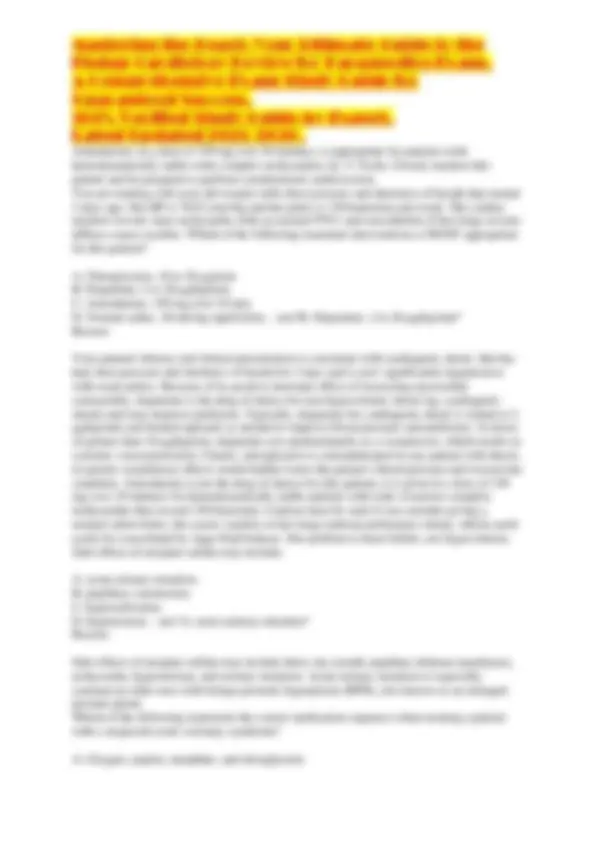
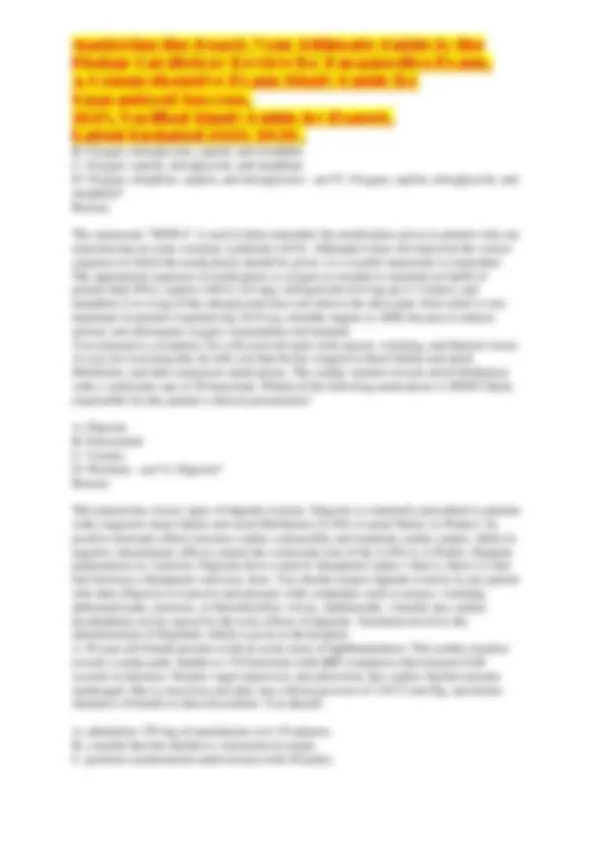
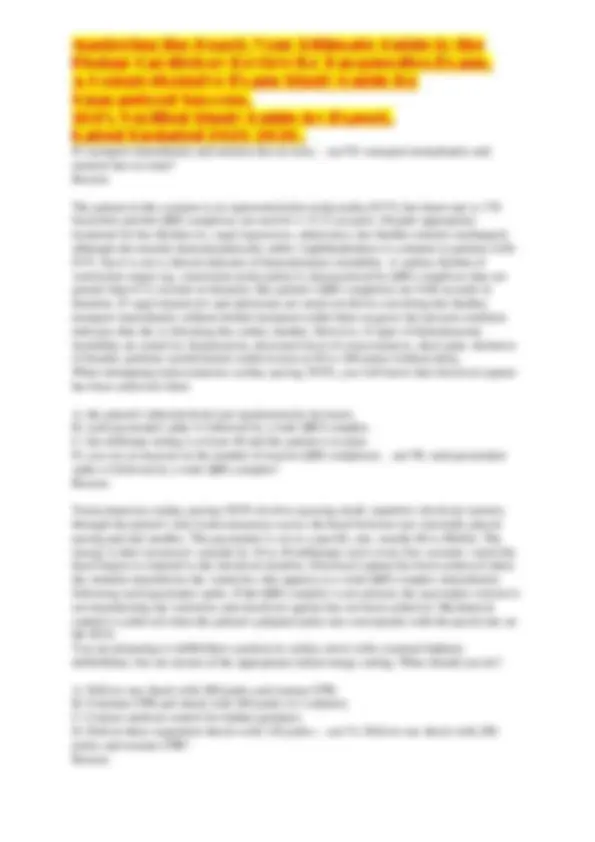
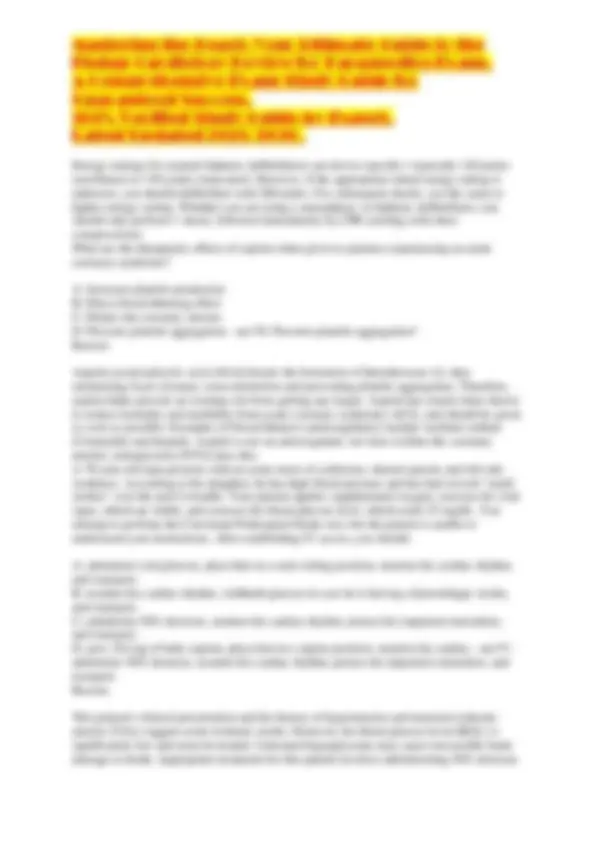
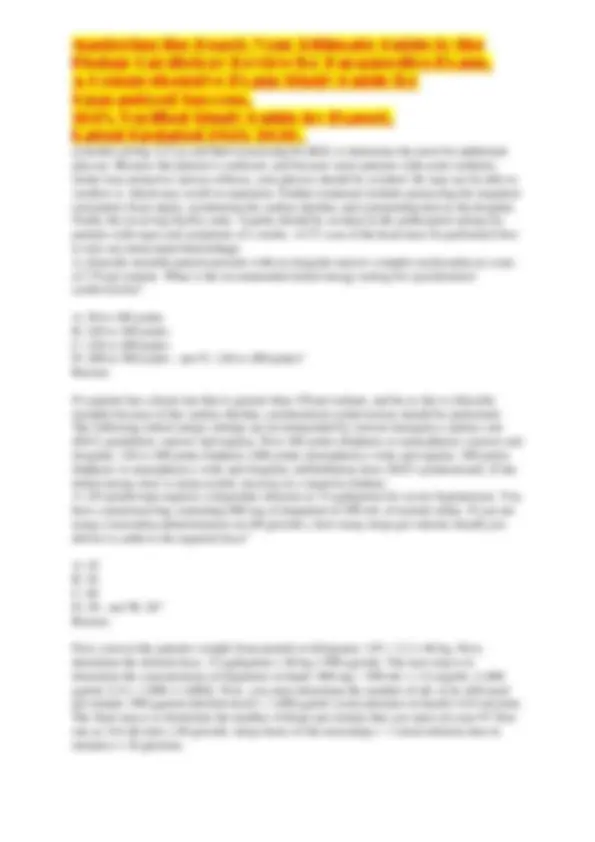
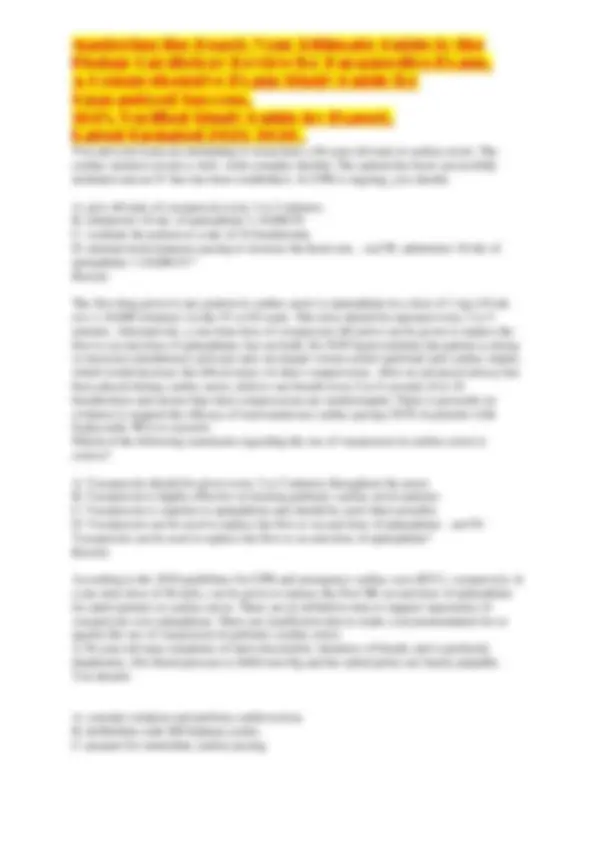
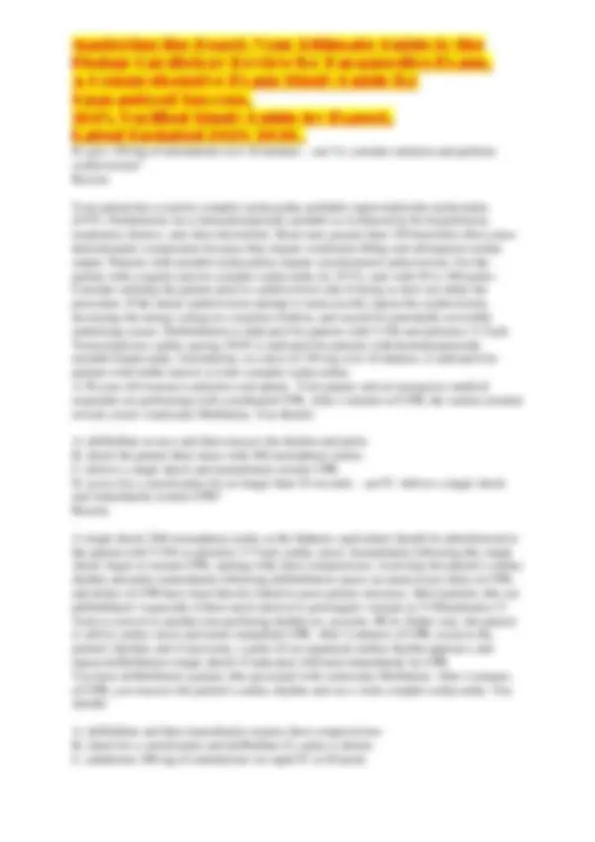
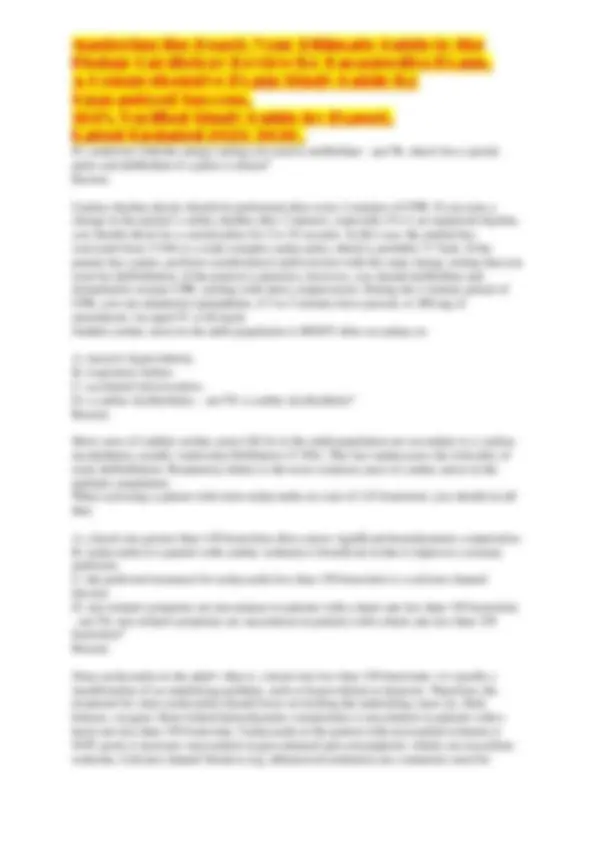
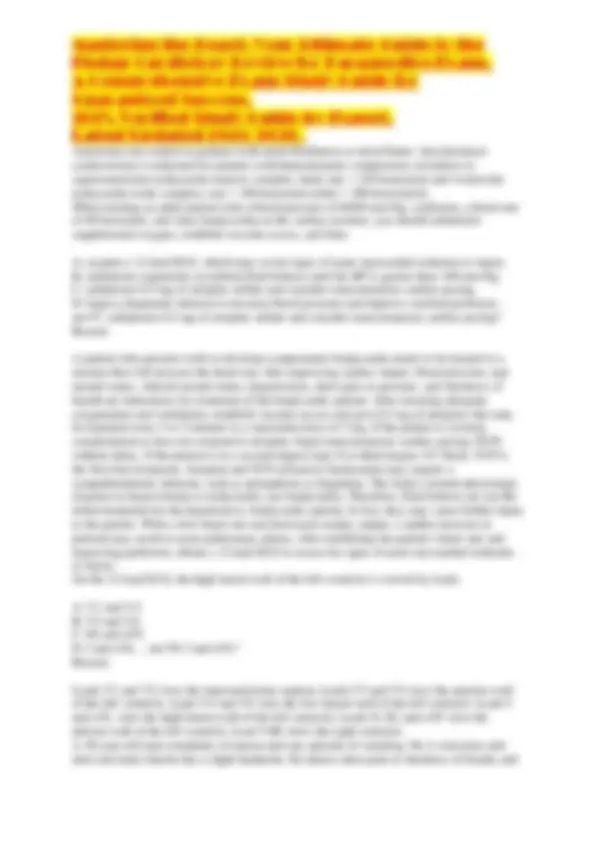
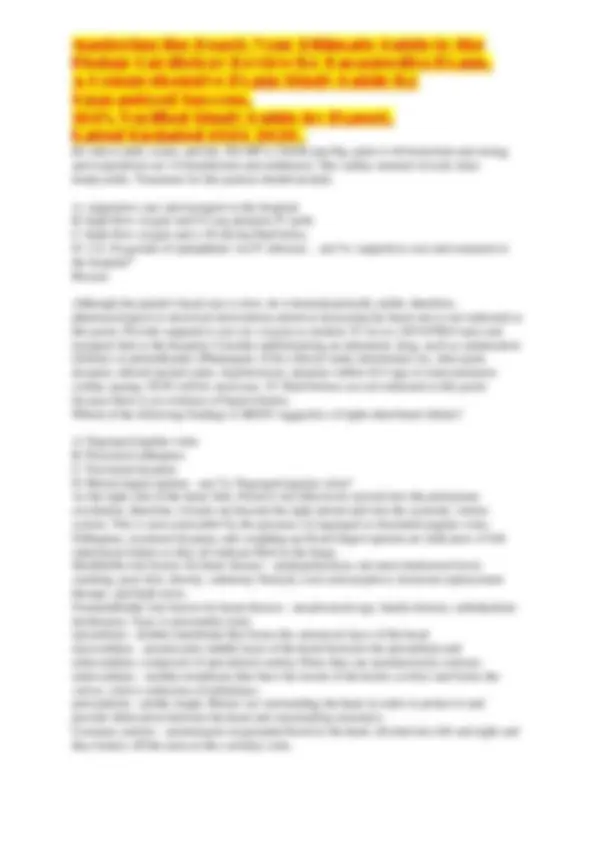
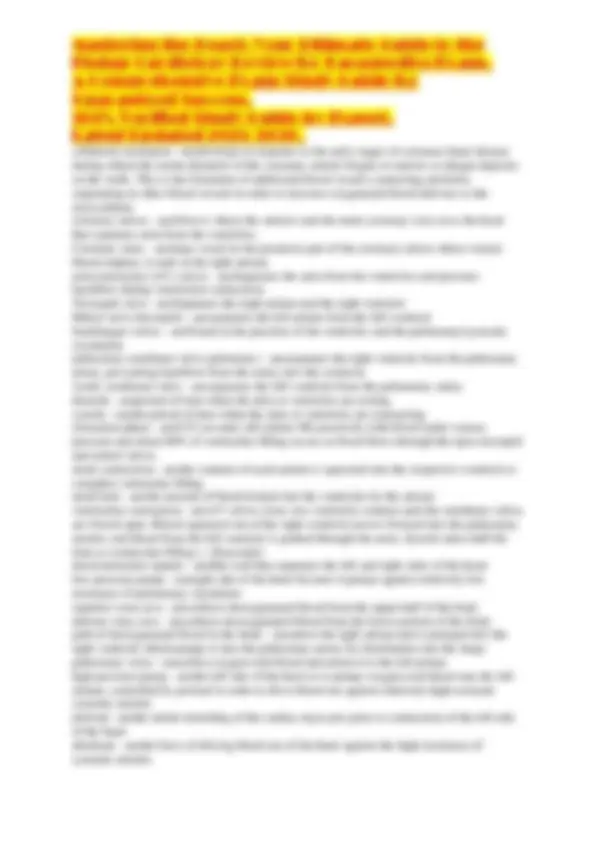
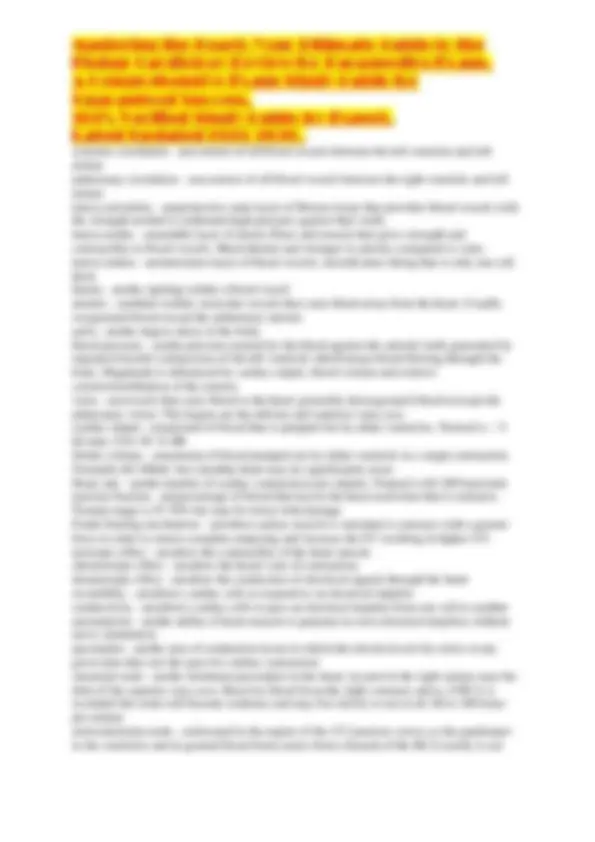
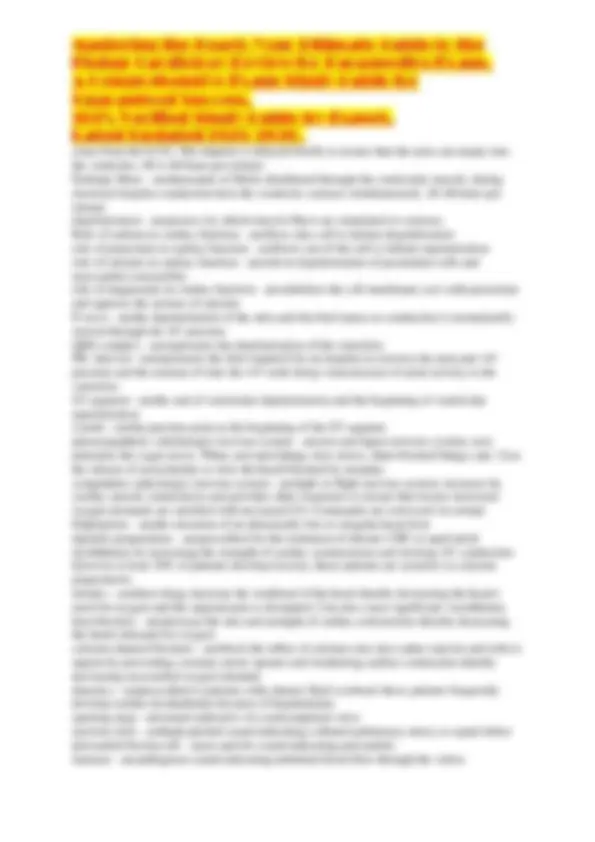
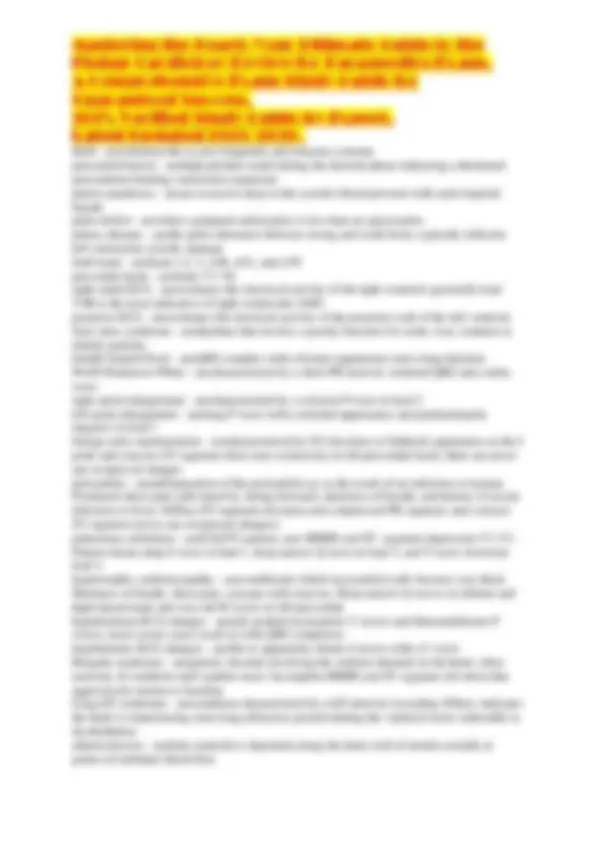
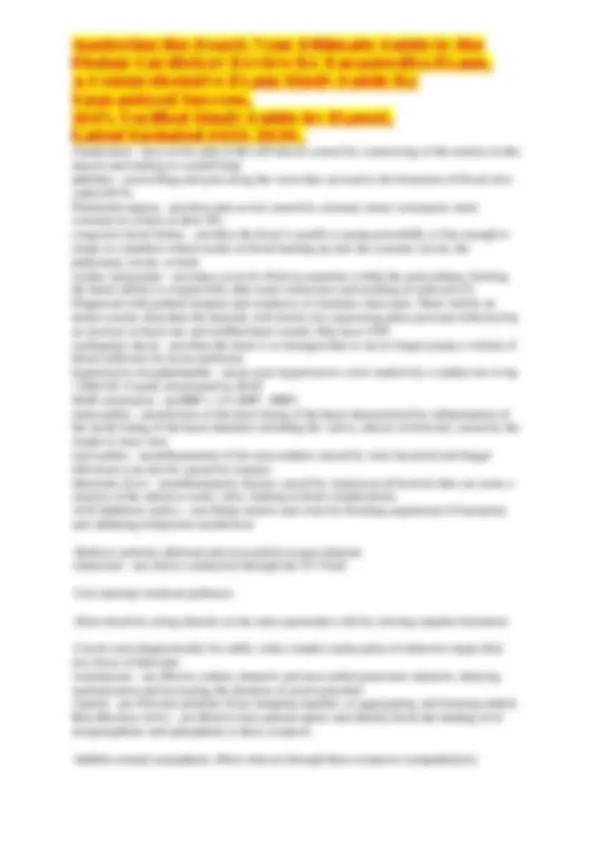
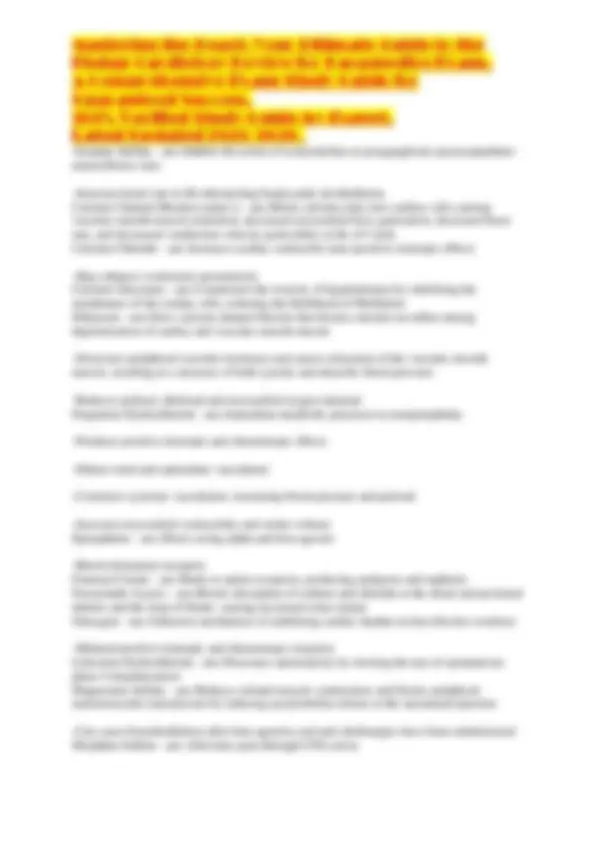
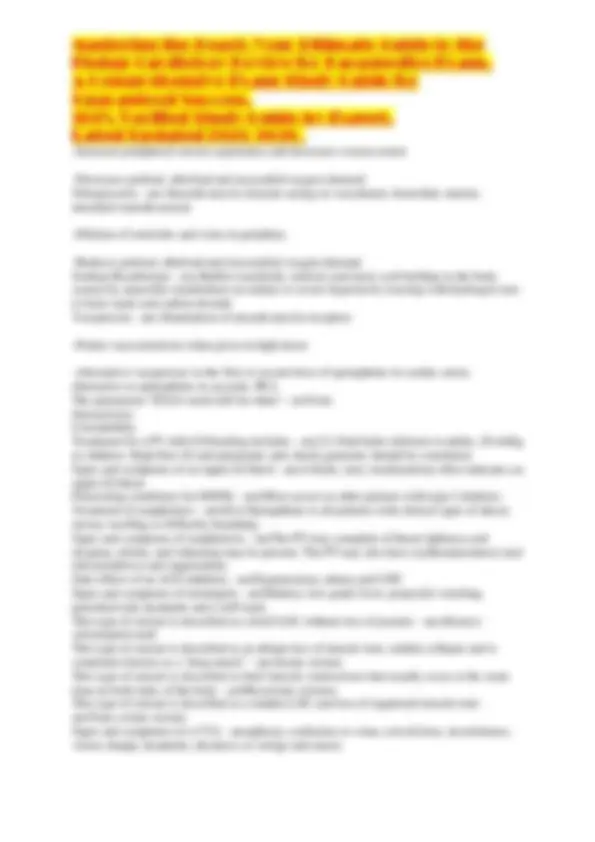
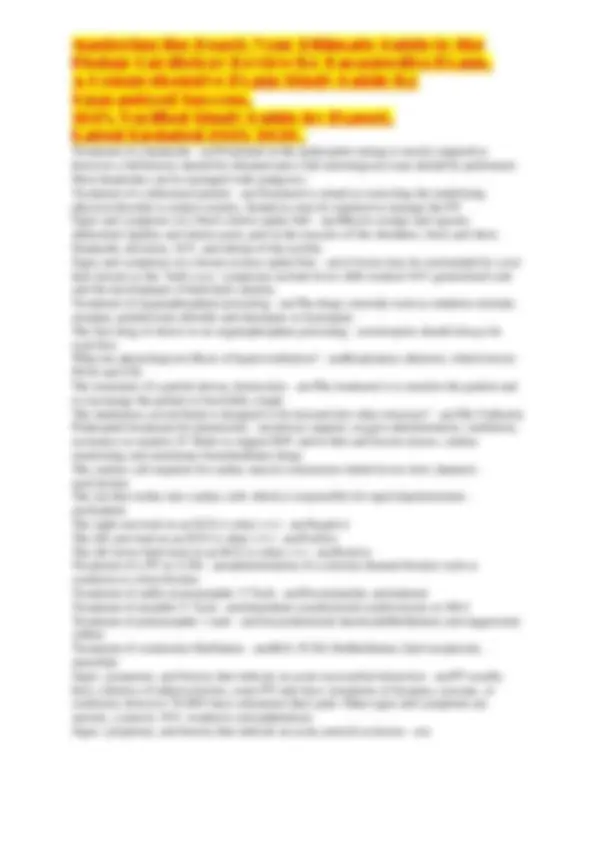


Study with the several resources on Docsity

Earn points by helping other students or get them with a premium plan


Prepare for your exams
Study with the several resources on Docsity

Earn points to download
Earn points by helping other students or get them with a premium plan
Community
Ask the community for help and clear up your study doubts
Discover the best universities in your country according to Docsity users
Free resources
Download our free guides on studying techniques, anxiety management strategies, and thesis advice from Docsity tutors
Mastering the Heart: Your Ultimate Guide to the Fisdap Cardiology Review for Paramedics Exam. A Comprehensive Exam Study Guide for Guaranteed Success. 100% Verified Study Guide by Expert. Latest Updated 2025/2026.
Typology: Exams
1 / 105

This page cannot be seen from the preview
Don't miss anything!





























































































You respond to a residence for a 68-year-old male with nausea, vomiting, and blurred vision. As you are assessing him, he tells you that he has congestive heart failure and atrial fibrillation, and takes numerous medications. The cardiac monitor reveals atrial fibrillation with a ventricular rate of 50 beats/min. Which of the following medications is MOST likely responsible for this patient's clinical presentation? - ansDigoxin. This patient has classic signs of digitalis toxicity. Digoxin is commonly prescribed to patients with congestive heart failure and atrial fibrillation (A-Fib) or atrial flutter (A-Flutter). Its positive inotropic effects increase cardiac contractility and maintain cardiac output, while its negative chronotropic effects control the ventricular rate of the A-Fib or A-Flutter. Digitalis preparations (ie, Lanoxin, Digoxin) have a narrow therapeutic index—that is, there is a fine line between a therapeutic and toxic dose. You should suspect digitalis toxicity in any patient who takes Digoxin or Lanoxin and presents with complaints such as nausea, vomiting, abdominal pain, anorexia, or blurred/yellow vision. Additionally, virtually any cardiac dysrhythmia can be caused by the toxic effects of digitalis. Treatment involves the administration of Digibind, which is given at the hospital. Which of the following is an absolute contraindication for fibrinolytic therapy? - ansSubdural hematoma 3 years ago. According to current emergency cardiac care (ECC) guidelines, absolute contraindications for fibrinolytic therapy include ANY prior intracranial hemorrhage (ie, subdural, epidural, intracerebral hematoma); known structural cerebrovascular lesion (ie, arteriovenous malformation); known malignant intracranial tumor (primary or metastatic); ischemic stroke within the past 3 months, EXCEPT for acute ischemic stroke within the past 3 hours; suspected aortic dissection; active bleeding or bleeding disorders (except menses); and significant closed head trauma or facial trauma within the past 3 months. Relative contraindications (eg, the physician may deem fibrinolytic therapy appropriate under certain circumstances) include, a history of chronic, severe, poorly-controlled hypertension; severe uncontrolled hypertension on presentation (SBP > 180 mm Hg or DBP > 110 mm Hg); ischemic stroke greater than 3 months ago; dementia; traumatic or prolonged (> 10 minutes) CPR or major surgery within the past 3 weeks; recent (within 2 to 4 weeks) internal bleeding; noncompressible vascular punctures; pregnancy; prior exposure (> 5 days ago) or prior allergic reaction to streptokinase or anistreplase; active peptic ulcer; and current use of anticoagulants (ie, Coumadin). A middle-aged man presents with chest discomfort, shortness of breath, and nausea. You give him supplemental oxygen and continue your assessment. As your partner is attaching the ECG leads, you should: - ansAdminister up to 325 mg of aspirin. Since oxygen has already been administered to this patient and your partner is attaching the ECG leads, you should administer aspirin (160 to 325 mg, non-enteric-coated). Early administration of aspirin has clearly been shown to reduce mortality and morbidity in patients experiencing an acute coronary syndrome (ACS). After establishing vascular access, you should assess his vital signs and then administer 0.4 mg of nitroglycerin (up to 3 doses, 5 minutes apart), provided that his systolic BP is greater than 90 mm Hg. If 3 doses of
nitroglycerin fail to completely relieve his chest discomfort, consider administering 2 to 4 mg of morphine IV, provided that his systolic BP remains above 90 mm Hg. Which of the following ECG lead configurations is correct? - ansTo assess lead II, place the negative lead on the right arm and the positive lead on the left leg. According to the Einthoven triangle, lead I is assessed by placing the negative (white) lead on the right arm and the positive (red) lead on the left arm. Lead II is assessed by placing the negative lead on the right arm and the positive lead on the left leg. Lead III is assessed by placing the negative lead on the left arm and the positive lead on the left leg. A 61-year-old male presents with chest pressure that woke him up from his nap 30 minutes ago. He is diaphoretic, anxious, and rates his pain as an an 8 over 10. His past medical history is significant for hypertension, type II diabetes, and coronary stent placement 2 months ago. He takes lisinopril, Plavix, and Glucophage, and is wearing a medical alert bracelet stating "allergic to salicylates." His blood pressure is 160/100 mm Hg, pulse is 110 beats/min, and respirations are 22 breaths/min. The 12-lead ECG shows sinus tachycardia with 3-mm ST segment elevation in leads V1 through V5. Which of the following treatment modalities is MOST appropriate for this patient? - ansSupplemental oxygen, vascular access, up to three 0.4 mg doses of nitroglycerin, and 2 to 4 mg of morphine sulfate if his systolic BP is greater than 90 mm Hg and he is still experiencing pain. The patient is experiencing an acute coronary syndrome (ACS). His 12-lead ECG indicates anteroseptal injury with lateral extension (ST elevation in leads V1 through V5). Appropriate treatment includes oxygen (maintain an SpO2 of greater than 94%), vascular access, up to three 0.4 mg doses of nitroglycerin (NTG), and 2 to 4 mg of morphine if NTG fails to relieve his pain and his systolic BP is above 90 mm Hg. Some EMS systems may use fentanyl (Sublimaze) for analgesia. Aspirin, a salicylate, is also given to patients with ACS; however, this patient is allergic to salicylates. Obtain a right-sided 12-lead ECG in patients with signs of inferior wall injury (ST elevation in leads II, III, aVF). Inferior wall infarctions may involve the right ventricle; a right-sided 12-lead ECG will help confirm this. Apply the multi- pads to the patient, not because he is at risk for bradycardia (more common with inferior infarctions), but because he is at risk for cardiac arrest due to V-Fib or pulseless V-Tach. You and your team are performing CPR on a 70-year-old male. The cardiac monitor reveals a slow, organized rhythm. His wife tells you that he goes to dialysis every day, but has missed his last three treatments. She also tells you that he has high blood pressure, hyperthyroidism, and has had several cardiac bypass surgeries. Based on the patient's medical history, which of the following conditions is the MOST likely underlying cause of his condition? - ansHyperkalemia. Although any of the listed conditions could be causing this patient's condition, the fact that he missed his last three dialysis treatments should make you most suspicious for hyperkalemia. Dialysis filters metabolic waste products from the blood in patients with renal insufficiency or failure. If the patient is not dialyzed, these waste products, including potassium and other electrolytes, accumulate to toxic levels in the blood. In addition to performing high-quality CPR, managing the airway, and administering epinephrine, your protocols may call for the administration of calcium chloride and sodium bicarbonate if hyperkalemia is suspected.
In general patient assessment, the main purpose of listening to heart sounds is to identify the "lub-dub" that indicates the cardiac valves are functioning properly. S1 (lub) occurs near the beginning of ventricular contraction, when the tricuspid and mitral valves close. S2 (dub) occurs near the end of the ventricular contraction, when the pulmonary and aortic valves close. Although cardiac rate and regularity can be assessed by listening to heart sounds (apical pulse), the quality of the heartbeat can only be assessed by palpating the pulse. The point of maximal impulse (PMI)—also called the apical thrust—is not heard, but rather seen. The PMI, which is normally located on the left anterior part of the chest in the midclavicular line at the fifth intercostal space, occurs when the heart's apex rotates forward with systole and gently beats against the chest wall, producing a visible pulsation. Which of the following represents the correct adult dosing regimen for adenosine? - ans6 mg, followed by 12 mg in 2 minutes if needed. According to the 2010 guidelines for CPR and emergency cardiac care (ECC), the correct dosing regimen of adenosine for a hemodynamically stable patient with a narrow-complex tachycardia is 6 mg via rapid (over 1 to 3 seconds) IV push. If needed, adenosine can be repeated in 1 to 2 minutes in a dose of 12 mg rapid IV push. You should interpret the following cardiac rhythm as: - ansAtrial flutter with a fixed block. Because of the typical "sawtooth" flutter (F) waves, this rhythm is interpreted as atrial flutter (A-Flutter). The block is fixed in that the ratio of F waves to QRS complexes is consistent (2:1). A-Flutter with a variable block occurs when the ratio of F waves to QRS complexes is different. Atrial fibrillation (A-Fib) is characterized by an irregularly irregular rhythm with no identifiable P waves. A type II second-degree AV block is characterized by a rhythm in which some P waves are blocked (eg, they are not followed by QRS complexes). Cardioversion involves delivering a shock that is synchronized to occur during the: - ansR wave. Cardioversion involves delivering a shock that is synchronized to occur during the R wave, which is when the heart is absolutely refractory. This prevents the shock from occurring during the relative refractory period (the downslope of the T wave). Depolarization that occurs during the relative refractory period may induce a non-perfusing ventricular dysrhythmia, such as pulseless V-Tach or V-Fib. Synchronized cardioversion is indicated for patients with supraventricular or ventricular tachycardia who have a pulse, but are hemodynamically unstable. Which of the following electrolytes moves slowly into the cardiac cell and maintains the depolarized state of the cell membrane? - ansCalcium. The process of depolarization begins as sodium ions rush into the cell. At the same time, calcium ions enter the cell—albeit more slowly and through specialized channels—to help maintain the depolarized state of the cell membrane and to supply calcium ions for contraction of cardiac muscle tissue. During repolarization, the sodium and calcium channels close, thus stopping the rapid influx of these ions. Then, special potassium channels open, allowing potassium ions to rapidly exit the cell. This helps restore the inside of the cell to its negative charge; the proper electrolyte distribution is then reestablished by pumping sodium
ions out of the cell and potassium ions back in. After the potassium channels close, the sodium-potassium pump helps move sodium and potassium ions back to their respective locations. For every three sodium ions the pump moves out of the cell, it moves two potassium ions into the cell, thereby maintaining the polarity of the cell membrane Which of the following cardiac rhythms is associated with bradycardia, and is characterized by regular R-R intervals and a greater ratio of P waves to QRS complexes? - ans3rd degree AV block. Third-degree AV block is caused by a complete block at the AV node. The SA node initiates impulses as usual; however, when they reach the AV node, they are blocked. Resultantly, the ventricles receive no electrical stimulus from the atria, so they initiate their own impulses, although at a much slower rate. On the ECG, this manifests as a bradycardic rhythm with more P waves than QRS complexes. The P-P intervals are regular (some P waves may not be visible because they are buried in a QRS complex), as are the R-R intervals; however, no relationship exists between a given P wave and QRS complex. Second-degree AV block type I (Wenkebach) is caused by a progressive delay at the AV node until an impulse is blocked from entering the ventricles. On the ECG, this manifests as a progressively lengthening P-R interval until a P wave is blocked (not followed by a QRS complex). At this point, the R-R interval becomes irregular, and the presence of this lone P wave increases the ratio of P waves to QRS complexes. Second-degree AV block type I may or may not be associated with bradycardia. Second-degree AV block type II is caused by an intermittent block at the AV node; it occurs when atrial impulses are not conducted to the ventricles. Unlike a second- degree AV block type I, however, a type II block is characterized by consistent P-R intervals of the P waves that are conducted. First-degree AV block is an abnormal delay at the AV node; on the ECG, this manifests with PR intervals greater than 0.20 seconds (120 ms) in duration. In first-degree AV block, all of the atrial impulses are conducted through the AV node and into the ventricles. A 59-year-old male with a monomorphic wide-complex tachycardia at a rate of 220/min, a blood pressure of 80/50 mm Hg, and a decreased level of consciousness, should be treated with: - ansSynchronized cardioversion. The patient in this scenario is likely in ventricular tachycardia (V-Tach). Approximately 90% of wide-complex tachycardias are ventricular in origin. Furthermore, he is hypotensive and has a decreased level of consciousness—signs of hemodynamic compromise. To prevent his condition from deteriorating further, immediate synchronized cardioversion, starting with 100 joules, is indicated. Monophasic (or biphasic equivalent) defibrillation is indicated for patients with pulseless V-Tach and ventricular fibrillation (V-Fib). Amiodarone (150 mg over 10 minutes) is indicated for patients with V-Tach who have a pulse, but are hemodynamically stable; it may also be used as an adjunct for patients with unstable V-Tach when cardioversion alone is not effective. Magnesium sulfate (1 to 2 g) is indicated for patients with torsade de pointes—a variant of polymorphic V-Tach. ECG indicators of Wolff-Parkinson-White (WPW) syndrome include: - ansShort PR intervals, delta waves, and QRS widening.
glucose. Because the patient is confused, and because some patients with acute ischemic stroke lose protective airway reflexes, oral glucose should be avoided. He may not be able to swallow it, which may result in aspiration. Further treatment includes protecting his impaired extremities from injury, monitoring his cardiac rhythm, and transporting him to the hospital. Notify the receiving facility early. Aspirin should be avoided in the prehospital setting for patients with signs and symptoms of a stroke. A CT scan of the head must be performed first to rule out intracranial hemorrhage. Which of the following clinical presentations is MOST consistent with an acute ischemic stroke involving the left cerebral hemisphere? - ansDysarthria, confusion, right side hemiparesis, left side facial droop. Acute ischemic strokes represent approximately 75% of all strokes. Each cerebral hemisphere controls functions on the contralateral (opposite) side of the body; therefore, sensory and motor deficits (ie, hemiparesis, hemiparalysis) are observed on the side of the body opposite the stroke. However, because the facial nerves do not decussate (cross as they leave the cerebral cortex, move through the brainstem, and arrive at the spinal cord), facial droop is typically observed on the ipsilateral (same) side as the stroke. Pupillary changes, if present, will also occur on the same side as the stroke because of optic nerve crossover in the brain. Other common signs of acute ischemic stroke include dysarthria (slurred speech), dysphasia (difficulty speaking or understanding), aphasia (inability to speak or understand), and mental status changes. In contrast to acute ischemic stroke, acute hemorrhagic stroke (caused by a ruptured cerebral artery) typically presents with more ominous signs, which include a sudden, severe headache that is followed by a rapid decline in level of consciousness. Because bleeding is occurring within the brain, intracranial pressure increases, resulting in signs such as decorticate (flexor) or decerebrate (extensor) posturing, asymmetric or bilaterally dilated pupils, and Cushing's triad (hypertension, bradycardia, abnormal respiratory pattern). A 2 7 - year-old female complains of palpitations. The cardiac monitor reveals a narrow- complex tachycardia at 180/min. She denies any other symptoms, and states that this has happened to her before, but it typically resolves on its own. Her blood pressure is 126/66 mm Hg, pulse is 180 beats/min, and respirations are 16 breaths/min. After attempting vagal maneuvers and giving two doses of adenosine, her cardiac rhythm and vital signs remain unchanged. You should: - ansTransport at once, reassess her frequently, and perform synchronized cardioversion if necessary. Although the patient is in supraventricular tachycardia (SVT), she remains stable following your initial efforts to slow her heart rate with vagal maneuvers and adenosine. Her failure to respond to initial treatment does not automatically make her unstable. Simply transport her, closely monitor her en route, and be prepared to cardiovert her if she does become unstable (ie, hypotension, altered mental status, chest pain). Unless specified in your local protocols, pharmacologic therapy beyond adenosine (ie, calcium channel blockers, amiodarone) is typically not indicated in the field for stable patients with SVT, although these medications may be given in the emergency department. However, if your protocols or medical control call for the administration of diltiazem (Cardizem), the initial dose is 0.25 mg/kg. You should interpret the following cardiac rhythm as: - ansThird-degree AV block.
The rhythm is regular, with a ventricular rate of approximately 40 to 50 beats/min. It has wide (greater than 120 ms [0.12 sec]) QRS complexes and more P waves than QRS complexes. Because there is no relationship between any one P wave to a given QRS complex, this is a third-degree AV block, also called complete heart block. First-degree AV block is characterized by P-R intervals that exceed 200 ms (0.20 seconds [5 small boxes]), although there is a consistent 1:1 P-to-QRS ratio; unless ectopic compexes are present, it is usually a regular rhythm. Second-degree AV block type I is characterized by P-R intervals that progressively lengthen until a P wave is blocked (not followed by a QRS complex); it is an irregular rhythm. Second-degree AV block type II, which may be regular or irregular, is characterized by more P waves than QRS complexes; however, the P-R intervals of the conducted complexes are the same. A 49-year-old male complains of generalized weakness that began about a week ago. He is conscious and alert and is breathing adequately. His blood pressure is 138/78 mm Hg, pulse is 130 beats/min and irregular, and respirations are 14 breaths/min. You administer supplemental oxygen and apply the cardiac monitor, which reveals atrial fibrillation; a 12- lead ECG tracing reveals the same. The patient denies any significant medical problems and takes no medications. After establishing IV access, you should: - ansAdminister 0.25 mg/kg of diltiazem and transport for evaluation. In the absence of any significant medical history, this patient's weakness probably signaled the onset of his atrial fibrillation (A-Fib). New-onset A-Fib of greater than 48 hours' duration should not be treated with synchronized cardioversion until the patient is adequately anticoagulated first (ie, Coumadin). Blood can stagnate in the fibrillating atria, which increases the risk of clot formation; cardioversion may dislodge these clots, resulting in a stroke, pulmonary embolism, or myocardial infarction. Furthermore, this patient is hemodynamically stable and is not in need of electrical therapy. Appropriate treatment for a patient with A-Fib or atrial flutter (A-Flutter) with a rapid ventricular rate (RVR) involves controlling the ventricular rate with a calcium-channel blocker. Diltiazem (Cardizem) is the most common drug used for this purpose. The initial dose is 0.25 mg/kg, which may be repeated in 15 minutes in a dose of 0.35 mg/kg. Amiodarone may be used to terminate new- onset A-Fib or A-Flutter, but is uncommonly given for this purpose in the prehospital setting. Vagal maneuvers and adenosine are indicated for narrow-complex tachycardias in an attempt to slow the ventricular rate so you can identify the underlying rhythm. You have already identified this patient's rhythm. If a patient was experiencing acute injury involving the interventricular septum and anterior wall of the left ventricle, you would expect the 12-lead ECG to reveal: - ansST segment elevation in leads V1 through V4. ST segment elevation that is equal to or greater than 1-mm in two or more contiguous leads indicates myocardial injury (eg, an acute MI in progress). ST segment depression and/or dynamic T wave inversion indicates myocardial ischemia. Leads V1 and V2 view the interventricular septum; leads V3 and V4 view the anterior wall of the left ventricle; leads V5, V6, I, and aVL view the lateral wall of the left ventricle; and leads II, III, and aVF view the inferior wall of the left ventricle. Therefore, if a patient is experiencing acute injury involving the interventricular septum and anterior wall of the left ventricle (anteroseptal
Occlusion of the right coronary artery would MOST likely result in: - ansSinoatrial node failure. The sinoatrial (SA) node is the dominant cardiac pacemaker; it sets the inherent rate at which the heart beats. The SA node receives blood from the right coronary artery (RCA); therefore, if the RCA is occluded (ie, acute myocardial infarction), the SA node will become ischemic and may cease functioning. If this occurs, the atrioventricular (AV) node would likely assume the role of the primary pacemaker, although at an inherently slower rate. If the SA node fails, the flow of electricity throughout the atria would likely suffer as well; this would result in a decrease in atrial kick—the volume of blood (about 20%) that is ejected from the atria to the ventricles (the other 80% fills the ventricles by gravity). Sudden cardiac arrest is more likely to occur following occlusion of the left main coronary artery. Ectopic ventricular complexes (eg, PVCs), although benign in many cases, may indicate irritability in the ventricles. Immediately after establishing a return of spontaneous circulation in a woman with ventricular fibrillation of short duration, you should: - ansAssess her ventilatory status and treat accordingly. Your first action after establishing return of spontaneous circulation (ROSC) in a patient— regardless of his or her arrest rhythm and duration—is to assess the patient's ventilatory status. If the patient is not breathing or is breathing inadequately, provide ventilatory support. After assessing and managing airway and breathing, assess the patient's blood pressure and stabilize it if it is low. Airway and circulatory support are critical following ROSC; inadequate ventilation and/or hypotension following cardiac arrest may lead to a recurrence of cardiac arrest. Depending on your local protocols, IV amiodarone may be given following ROSC. After assessing and maintaining respiratory and circulatory functions, obtain a 12- lead ECG if time allows. If the patient remains comatose following ROSC, consider inducing therapeutic hypothermia. A 56-year-old man presents with the cardiac rhythm shown below. He complains of chest discomfort, shortness of breath, and is profusely diaphoretic. His blood pressure is 84/64 mm Hg and his radial pulses are barely palpable. You should: - ansConsider sedation and perform cardioversion. Your patient has a narrow-complex tachycardia, probably supraventricular tachycardia (SVT). Furthermore, he is hemodynamically unstable as evidenced by his hypotension, respiratory distress, and chest discomfort. Heart rates greater than 150 beats/min often cause hemodynamic compromise because they impair ventricular filling and subsequent cardiac output. Patients with unstable tachycardias require synchronized cardioversion. For the patient with a regular narrow-complex tachycardia (ie, SVT), start with 50 to 100 joules. Consider sedating the patient prior to cardioversion only if doing so does not delay the procedure. If the initial cardioversion attempt is unsuccessful, repeat the cardioversion, increasing the energy setting in a stepwise fashion, and search for potentially reversible underlying causes. Defibrillation is indicated for patients with V-Fib and pulseless V-Tach. Transcutaneous cardiac pacing (TCP) is indicated for patients with hemodynamically unstable bradycardia. Amiodarone, in a dose of 150 mg over 10 minutes, is indicated for patients with stable narrow or wide-complex tachycardias.
Which of the following interventions has the greatest impact on patient survival from sudden cardiac arrest? - ansEarly CPR and defibrillation. Early CPR and defibrillation are the two interventions that will have the greatest impact on patient survival from sudden cardiac arrest (SCA). Early, effective CPR maintains perfusion to the body's vital organs until defibrillation can be provided. The most common initial cardiac rhythm observed during SCA is ventricular fibrillation (V-Fib). Early defibrillation, in conjunction with early CPR, greatly enhances the chance of establishing return of spontaneous circulation (ROSC). The probability of successful defibrillation decreases over time, especially if CPR is delayed. For each minute that V-Fib persists, the patient's chance of survival decreases by approximately 7% to 10%. Atropine sulfate exerts its therapeutic effect by: - ansOpposing the vagus nerve. Atropine sulfate is a parasympathetic blocker (parasympatholytic, vagolytic). It is used to increase the heart rate by opposing the vagus nerve when excessive parasympathetic (vagal) tone causes symptomatic bradycardia. Alpha adrenergic agonists, such as norepinephrine (Levophed), primarily stimulate alpha-1 receptors and cause vasoconstriction. Drugs such as propranolol (Inderal) and prazosin (Minipress) block sympathetic nervous system activity by binding to beta and alpha receptors, respectively. Beta receptor blockade causes a decrease in heart rate (negative chronotropy), a decrease in contractility (negative inotropy), and a decrease in electrical conduction velocity (negative dromotropy). Alpha receptor blockade causes vasodilation, and a subsequent decrease in blood pressure. Drugs that increase cardiac contractility, such as dopamine (Intropin), do so through their positive inotropic effects. You are treating a 68-year-old woman with chest pressure and shortness of breath that started 2 days ago. Her BP is 76/52 mm Hg and her pulse is 130 beats/min and weak. The cardiac monitor reveals sinus tachycardia with occasional PVCs and auscultation of her lungs reveals diffuse coarse crackles. Which of the following treatment interventions is MOST appropriate for this patient? - ansDopamine, 2 to 20 μg/kg/min. Your patient's history and clinical presentation is consistent with cardiogenic shock. She has had chest pressure and shortness of breath for 2 days and is now significantly hypotensive with weak pulses. Because of its positive inotropic effect of increasing myocardial contractility, dopamine is the drug of choice for non-hypovolemic shock (eg, cardiogenic shock) and may improve perfusion. Typically, dopamine for cardiogenic shock is started at 2 μg/kg/min and titrated upwards as needed to improve blood pressure and perfusion. At doses of greater than 10 μg/kg/min, dopamine acts predominantly as a vasopressor, which results in systemic vasoconstriction. Clearly, nitroglycerin is contraindicated in any patient with shock; its potent vasodilatory effects would further lower the patient's blood pressure and worsen her condition. Amiodarone is not the drug of choice for this patient; it is given in a dose of 150 mg over 10 minutes for hemodynamically stable patients with wide or narrow-complex tachycardias that exceed 150 beats/min. Caution must be used if you consider giving a normal saline bolus; the coarse crackles in her lungs indicate pulmonary edema, which could easily be exacerbated by large fluid boluses. Her problem is heart failure, not hypovolemia. Appropriate treatment for asystole includes: - ansEpinephrine 1:10,000 and advanced airway management.
Pulseless electrical activity (PEA) exists when an unresponsive, apneic, pulseless patient presents with a regular cardiac rhythm. Treatment for PEA includes immediate high-quality CPR with minimal interruptions, obtaining vascular access (IV or IO), 1 mg of epinephrine every 3 to 5 minutes, advanced airway management (ie, ET tube, multilumen or supraglottic airway), and assessing for and treating reversible causes (Hs and Ts). Vasopressin, in a one- time dose of 40 units, can be given to replace the first or second dose of epinephrine, but not both. There are insufficient data to recommend transcutaneous pacing (TCP) for patients with bradycardic PEA or asystole, and the routine use of calcium chloride during cardiac arrest is not recommended. An older man is suddenly awakened in the middle of the night, gasping for air. He is extremely restless and pale, and is coughing up blood. His clinical presentation is MOST consistent with: - ansLeft side heart failure. Waking up in the middle of the night with severe difficulty breathing (paroxysmal nocturnal dyspnea [PND]) and coughing up blood or blood-tinged sputum (hemoptysis) are consistent with left-sided heart failure and pulmonary edema. Right-sided heart failure typically does not present with respiratory distress; it commonly manifests with jugular venous distention and peripheral edema. Shortness of breath and hemoptysis are not consistent with a gastrointestinal (GI) bleed; signs of a GI bleed include abdominal pain, vomiting up blood (hematemesis), which may be bright red or have a coffee-ground appearance; dark, tarry stools (melena); or bright red blood in the stool (hematochezia). Because left-sided heart failure can be caused by other factors, such as a long history of poorly-controlled hypertension, angina may or may not be present. A 145-pound man requires a dopamine infusion at 15 μg/kg/min for severe hypotension. You have a premixed bag containing 800 mg of dopamine in 500 mL of normal saline. If you are using a microdrip administration set (60 gtts/mL), how many drops per minute should you deliver to achieve the required dose? - ans36. First, convert the patient's weight from pounds to kilograms: 145 ÷ 2.2 = 66 kg. Next, determine the desired dose: 15 μg/kg/min × 66 kg = 990 μg/min. The next step is to determine the concentration of dopamine on hand: 800 mg ÷ 500 mL = 1.6 mg/mL (1, μg/mL [1.6 × 1,000 = 1,600]). Now, you must determine the number of mL to be delivered per minute: 990 μg/min [desired dose] ÷ 1,600 μg/mL [concentration on hand] = 0.6 mL/min. The final step is to determine the number of drops per minute that you must set your IV flow rate at: 0.6 mL/min × 60 gtts/mL (drop factor of the microdrip) ÷ 1 (total infusion time in minutes) = 36 gtts/min. A 35-year-old female experienced a syncopal episode shortly after complaining of palpitations. She was reportedly unconscious for less than 10 seconds. Upon your arrival, she is conscious and alert, denies any injuries, and states that she feels fine. She further denies any significant medical history. Her vital signs are stable and the cardiac monitor reveals a sinus rhythm with frequent premature atrial complexes. On the basis of this information, what MOST likely caused her syncopal episode? - ansParoxysmal supraventricular tachycardia. Syncope (fainting) of cardiac origin is caused by a sudden decrease in cerebral perfusion secondary to a decrease in cardiac output. This is usually the result of an acute
bradydysrhythmia or tachydysrhythmia. In this particular patient, the presence of frequent premature atrial complexes (PACs), which indicates atrial irritability, suggests paroxysmal supraventricular tachycardia (PSVT) as the underlying dysrhythmia that caused her syncopal episode. In PSVT, the heart is beating so fast that ventricular filling and cardiac output decrease, which results in a transient decrease in cerebral perfusion. Not all patients with PSVT experience syncope. Many experience an acute onset of palpitations and/or lightheadedness that spontaneously resolves. Immediately following return of spontaneous circulation, the paramedic should: - ansReassess the patient's ventilatory status. Immediately following return of spontaneous circulation (ROSC), as evidenced by the presence of a pulse, the paramedic should reassess the patient's ventilatory status and continue to treat accordingly. Remember, if an advanced airway is placed during cardiac arrest, ventilations are given at a rate of one breath every 6 to 8 seconds (8 to 10 breaths/min) with continuous chest compressions. However, if ROSC occurs and the patient remains apneic, you should deliver one breath every 5 to 6 seconds (10 to 12 breaths/min) for the adult, or one breath every 3 to 5 seconds (12 to 20 breaths/min) for infants and children. Next, assess the patient's BP and use crystalloid fluid boluses or an inotropic drug (eg, dopamine) to treat hypotension and maintain adequate perfusion. If the patient remains comatose following ROSC, therapeutic hypothermia should be considered. Follow your local protocols. You have defibrillated a patient who presented with ventricular fibrillation. After 2 minutes of CPR, you reassess the patient's cardiac rhythm and see a wide-complex tachycardia. You should: - ansCheck for a carotid pulse and defibrillate if a pulse is absent. Cardiac rhythm checks should be performed after every 2 minutes of CPR. If you note a change in the patient's cardiac rhythm after 2 minutes, especially if it is an organized rhythm, you should check for a carotid pulse for 5 to 10 seconds. In this case, the patient has converted from V-Fib to a wide-complex tachycardia, which is probably V-Tach. If the patient has a pulse, perform synchronized cardioversion with the same energy setting that you used for defibrillation. If the patient is pulseless, however, you should defibrillate and immediately resume CPR, starting with chest compressions. During the 2-minute period of CPR, you can adminster epinephrine, if 3 to 5 minutes have passed, or 300 mg of amiodarone via rapid IV or IO push. A 59-year-old woman presents with a regular, narrow-complex tachycardia at a rate of 180 beats/min. She is conscious and alert, but complains of chest discomfort and has a blood pressure of 86/56 mm Hg. In addition to giving her supplemental oxygen, you should: - ansHave her chew and swallow 325 mg of aspirin. A regular, narrow complex tachycardia at a rate greater than 150 beats/min is consistent with supraventricular tachycardia (SVT). Although the patient is conscious and alert, she is complaining of chest discomfort and is hypotensive. Since she could be experiencing an acute coronary syndrome (ACS), you should instruct her to chew and swallow up to 325 mg of aspirin. Aspirin should be given to any patient suspected of experiencing an ACS, provided there are no contraindications (eg, allergy); it will not affect her blood pressure.
heartburn, acid reflux disease, and ulcers. Clonazepam (Klonopin) is a benzodiazepine sedative-hypnotic; it is used to treat anxiety. What are the physiologic effects of nitroglycerin when given to patients with cardiac-related chest pain, pressure, or discomfort? - ansSmooth muscle relaxation and decreased preload. Nitroglycerin (NTG) is a vasodilator. It relaxes the smooth muscle of the vascular walls, which promotes systemic venous pooling of blood. As a result, venous return to the right atrium (preload) is decreased; this decreases the cardiac workload. The amount of resistance that the left ventricle must contract against (afterload) is also decreased secondary to vasodilation. By dilating the coronary arteries, NTG increases blood supply to ischemic myocardium and may relieve the chest pain, pressure, or discomfort associated with acute coronary syndrome (ACS). Nitroglycerin is not an analgesic; if it relieves the patient's pain, it is because myocardial oxygen supply and demand have been rebalanced. A transmural myocardial infarction is defined as: - ansAn MI that involves the entire thickness of the left ventricular wall from endocardium to epicardium. A transmural myocardial infarction involves the entire thickness of the left ventricular wall from endocardium to epicardium; it is associated with ST-segment elevation and, eventually, the development of pathologic Q waves. A subendocardial infarction involves multiple areas of myocardial necrosis confined to the inner one third to one half of the left ventricular wall; subendocardial infarctions are also referred to as non-Q-wave infarctions. Myocardial ischemia caused by focal areas of spontaneous coronary vasospasm, which may lead to infarction, is called Prinzmetal's (variant) angina; the exact cause of this spontaneous coronary vasospasm is largely unknown. A 60-year-old female presents with confusion, shortness of breath, and diaphoresis. Her blood pressure is 70/40 mm Hg and her heart rate is 40 beats/min. The cardiac monitor reveals a slow, wide complex rhythm with dissociated P waves. After applying supplemental oxygen, you should: - ansBegin immediate transcutaneous pacing. The cardiac rhythm described is a third-degree (complete) AV block, and the patient is clinically unstable (ie, hypotension, altered mental status, shortness of breath). Third-degree AV block is characterized by a slow ventricular rate and no P-to-QRS relationship (AV dissociation). Patients with high-grade AV blocks (eg, second-degree type II, third-degree) are often clinically unstable and require immediate transcutaneous cardiac pacing (TCP). Atropine is an appropriate drug for clinically unstable patients with sinus bradycardia and bradycardia associated with low-grade AV blocks (eg, first-degree, second-degree type I); it is not recommended for high-grade AV blocks. If TCP is unsuccessful for this patient, consider an epinephrine infusion (2 to 10 μg/min) or a dopamine infusion (5 to 10 μg/kg/min), either of which may increase her heart rate and blood pressure. The patient's hypotension is secondary to severe bradycardia, not hypovolemia; therefore, a rapid IV fluid bolus is not indicated. If you have reason to suspect that the patient is experiencing an acute coronary syndrome (ACS), aspirin should be given. The initial dose of diltiazem for a 165 - pound patient is approximately: - ans19.
Diltiazem hydrochloride (Cardizem) is a calcium channel blocking drug that is used to treat rapid ventricular rates associated with atrial fibrillation or atrial flutter. It can also be used after adenosine to treat refractory reentry supraventricular tachycardia in hemodynamically stable patients. The initial dose of diltiazem is 0.25 mg/kg IV over 2 minutes; the average initial dose is 15 to 20 mg. It may be repeated in 15 minutes in a dose of 0.35 mg/kg IV over 2 minutes; the average second dose is 20 to 25 mg. A 165-pound patient weighs 75 kg. Therefore, the initial dose of diltiazem for a patient of this weight would be 18.75 mg (approximately 19 mg), and the second dose would be 26.25 mg (approximately 26 mg). A 65-year-old man with difficulty breathing and palpitations presents with the cardiac rhythm shown below, which you should interpret as: - ansSupraventricular tachycardia. Since this rhythm has narrow (less than 0.12 seconds) QRS complexes and a rate greater than 150 beats/min, it should be interpreted as supraventricular tachycardia (SVT), which means that its site of origin is above (supra) the level of the ventricles. SVT can be either atrial or junctional in origin. Atrial fibrillation is characterized by an irregularly irregular rhythm and no discernable P waves. Atrial flutter is characterized by flutter (F) waves that resemble a saw tooth. Ventricular tachycardia (V-Tach), in contrast to SVT, is characterized by wide (greater than 0.12 seconds) QRS complexes and no visible P waves. You and your team are attempting to resuscitate a 66-year-old man in cardiac arrest. The cardiac monitor reveals a slow, wide-complex rhythm. The patient has been successfully intubated and an IV line has been established. As CPR is ongoing, you should: - ansAadminister 10 mL of epinephrine 1:10,000 IV. The first drug given to any patient in cardiac arrest is epinephrine in a dose of 1 mg (10 mL of a 1:10,000 solution) via the IV or IO route. This dose should be repeated every 3 to 5 minutes. Alternatively, a one-time dose of vasopressin (40 units) can be given to replace the first or second dose of epinephrine, but not both. Do NOT hyperventilate the patient as doing so increases intrathoracic pressure and can impair venous return (preload) and cardiac output, which would decrease the effectiveness of chest compressions. After an advanced airway has been placed during cardiac arrest, deliver one breath every 6 to 8 seconds (8 to 10 breaths/min) and ensure that chest compressions are uninterrupted. There is presently no evidence to support the efficacy of transcutaneous cardiac pacing (TCP) in patients with bradycardic PEA or asystole. Which of the following signs or symptoms occurs more commonly in patients with stable angina than in those with unstable angina? - ansChest pain that begins during exertion. Angina pectoris occurs when the heart's demand for oxygen exceeds it's available supply (ischemia) and is a sign of coronary artery disease (CAD). Angina is classified as being stable or unstable. Stable angina typically follows a predictable pattern (ie, chest pain, pressure, or discomfort induced by exertion), lasts less than 15 minutes, and is usually relieved with rest and/or nitroglycerin. While unstable angina (preinfarction angina) can also occur during exertion, it more commonly occurs when the patient otherwise would not expect it to, such as when he or she is asleep or is otherwise resting. Furthermore, unstable angina is often not relieved by rest and/or nitroglycerin and typically lasts longer than 15 minutes. Chest pressure, tightness, or discomfort occurs in patients with both stable and unstable angina. If a
prematurely depolarizes the ventricles. A wide (> 0.12 seconds [120 ms]) QRS complex indicates an intraventricular conduction delay, such as a bundle branch block. P waves that vary in morphology (appearance) indicate more than one atrial pacemaker site; an example of this is an ectopic atrial rhythm. In contrast to unstable angina, stable angina occurs when a patient: - ansExperiences chest discomfort after a certain, predictable amount of exertion. Angina pectoris is a sign of coronary artery disease (CAD), and is the result of an imbalance in myocardial oxygen supply and demand. Stable angina occurs when the patient experiences chest pain or discomfort after a certain, predictable amount of exertion. Furthermore, the patient with stable angina typically knows what actions to take to relieve the pain (ie, rest, nitroglycerin). By contrast, unstable angina is characterized by noticeable changes in the frequency, severity, and degree of chest pain or discomfort. The patient experiences symptoms, which are often not relieved with rest and/or nitroglycerin, when myocardial oxygen demand is otherwise low (ie, sleep, rest). Unstable angina indicates advanced CAD; it is commonly referred to as preinfarction angina. According to the Los Angeles Prehospital Stroke Screen (LAPSS), the likelihood that a conscious patient with an acute atraumatic neurologic complaint is experiencing a stroke is HIGHEST if he or she: - ansDoes not have a history of seizures. The Los Angeles Prehospital Stroke Screen (LAPSS) is a useful tool for indentifying patients who are possibly experiencing a stroke. It requires the paramedic to rule out other causes of abnormal neurologic signs (eg, seizures, hypoglycemia). There are six components to the LAPSS. If any one of these items is checked "yes" or "unknown," you should notify the receiving facility as soon as possible and inform them that the patient is potentially experiencing a stroke. Bear in mind, however, that some patients who are experiencing a stroke may have unremarkable findings on the LAPSS (eg, all components of the LAPSS are checked "no"). Following are the six components of the LAPSS: (1) Age > 45 years; (2) History of seizures is absent; (3) Patient is not normally bedridden or confined to a wheelchair; (4) Blood glucose level is between 60 and 400 mg/dL; (5) Symptom duration is < 24 hours; (6) Unilateral asymmetry in any of the following categories: Facial smile/grimace, Grip strength, or Arm strength (eg, arm drift). Which of the following statements regarding right ventricular failure (RVF) is correct? - ansSacral and pedal edema are common signs of RVF. The most common cause of right ventricular failure (RVF) is left ventricular failure (LVF). When the left ventricle fails, blood backs up into the lungs and eventually into the pulmonary circulation, resulting in pulmonary hypertension. Because the right ventricle must work harder to overcome the increased resistance in the pulmonary circulation, it eventually fails as an effective forward pump. As a result, blood backs up into the systemic circulation, resulting in jugular venous distention, hepatomegaly (enlarged liver), and peripheral edema— especially to dependent areas of the body (eg, extremities, the sacrum in bedridden patients). In patients with severe RVF, total body edema (anasarca) may be present. Hypotension may be observed in patients with RVF, and commonly occurs as the result of right ventricular infarction (RVI). Treat the hypotensive patient with crystalloid fluid boluses (250 to 500
mL), which will increase preload and may improve contractility via the Starling effect. Vasodilators (ie, morphine, nitroglycerin) should not be administered to patients with RVF; they may induce or exacerbate hypotension. A 71-year-old male presents with chest pain and shortness of breath. He is conscious, but confused, and is profusely diaphoretic. He has weakly palpable radial pulses, a BP of 70/ mm Hg, and diffuse crackles in all lung fields. You administer high-flow oxygen and apply the cardiac monitor, which reveals sinus tachycardia. The closest appropriate hospital is 40 miles away. Which of the following is the MOST appropriate next action? - ansBegin an infusion of dopamine. The patient in this scenario has likely experienced an acute myocardial infarction and is now in cardiogenic shock (pump failure). Cardiogenic shock is characterized by general signs of shock (eg, tachycardia, diaphoresis), hypotension, altered mental status, and pulmonary congestion—a sign of significant left ventricular damage and decreased stroke volume. After ensuring airway patency and adequate oxygenation and ventilation, your priority is to improve perfusion. Crystalloid fluid boluses, at least not large fluid boluses (ie, 20 mL/kg), are not appropriate for this patient; they may exacerbate his pulmonary edema and further impair pulmonary respiration. Dopamine is a more appropriate intervention. In a dosing range of 5 to 10 μg/kg/min, dopamine possesses positive inotropic effects, which increases myocardial contractility and may improve cardiac output. Rapid transport for this patient is essential; because of your extended transport time, start the dopamine infusion en route. Unfortunately, true cardiogenic shock has a high mortality rate. You are treating a patient with ventricular fibrillation. As the defibrillator is charging, you should: - ansEnsure that CPR is continuing until the defibrillator is charged. A major emphasis is placed on minimizing interruptions in CPR. Evidence has shown that even a brief pause in chest compressions can result in a significant decrease in coronary and cerebral perfusion. Therefore, CPR should be continuing—even as the defibrillator is charging. When the defibrillator is charged, ensure (visually and verbally) that nobody is touching the patient, and then deliver the shock. When defibrillating a patient with V-Fib, you must ensure that the synchronizer is off; the synchronizer will not be able to identify an R wave in V-Fib due to the chaotic nature of the dysrhythmia. Cardiac arrest patients (adults, children, and infants) should be ventilated at a rate of 8 to 10 breaths/min after an advanced airway device has been placed (eg, ET tube, multilumen airway, supraglottic airway). Excessive ventilation rates should be avoided; they cause increased intrathoracic pressure, which may impair venous return and cardiac output. Which of the following clinical presentations is MOST consistent with dissection of the ascending aorta? - ansAcute tearing pain in between the scapulae, blood pressure discrepancy between arms, maximal pain severity from the onset. Aortic dissection occurs when the layers of the aorta undergo destructive changes, resulting in an aneurysm (weakening and ballooning of the arterial wall). In dissection of the ascending aorta, the patient typically experiences an acute onset of ripping, tearing, or stabbing pain in the anterior chest or in between the scapulae. In some patients, it may be difficult to differentiate the pain of acute aortic dissection from that of acute myocardial infarction